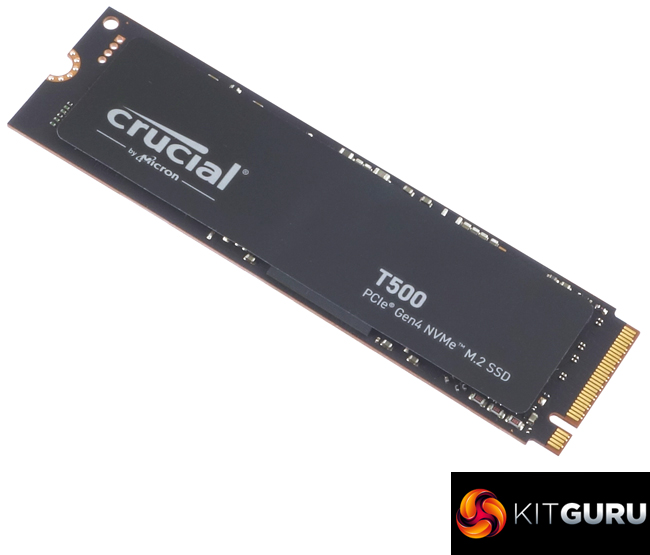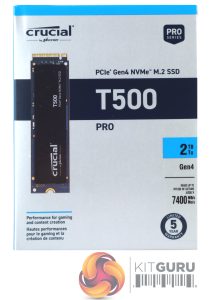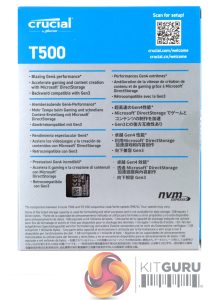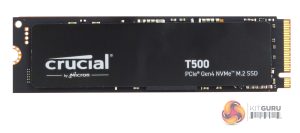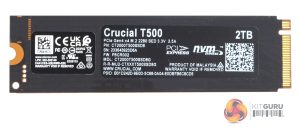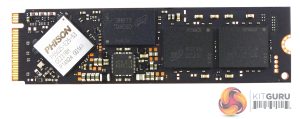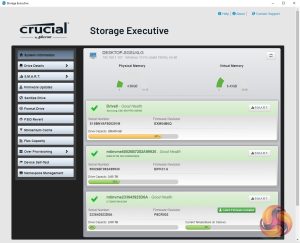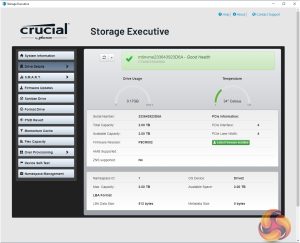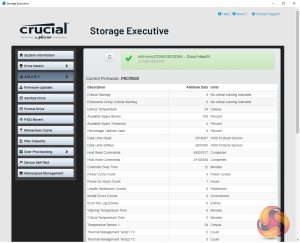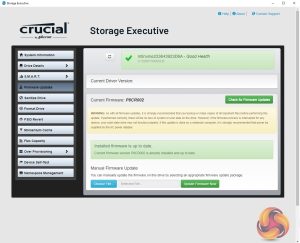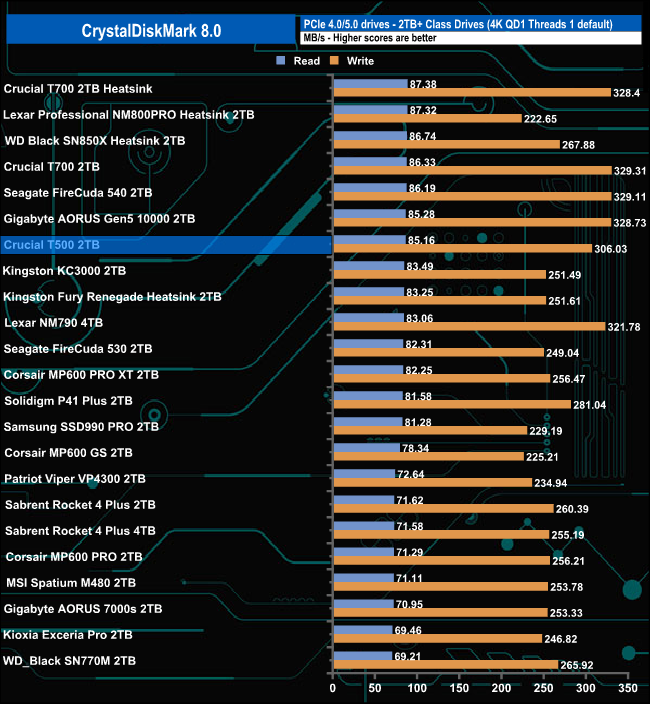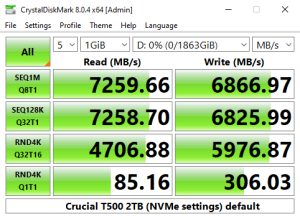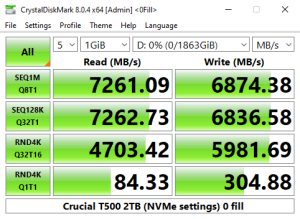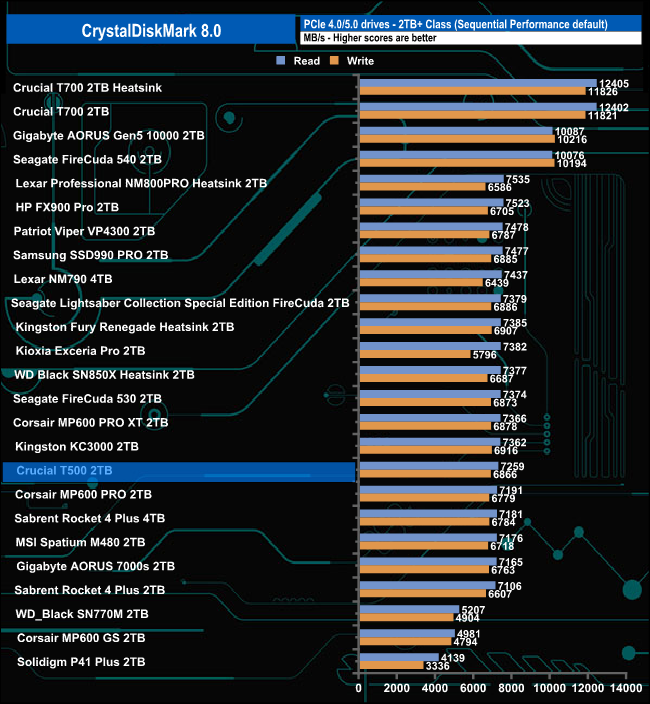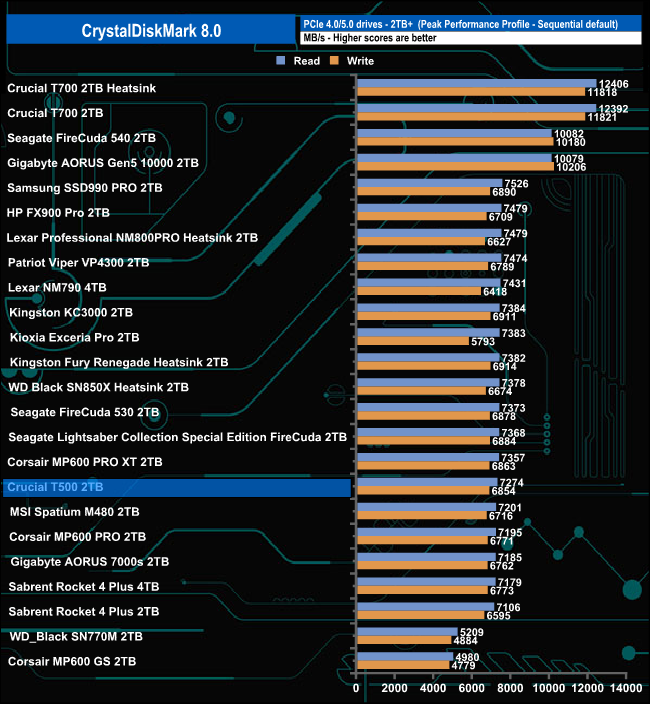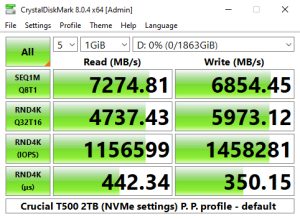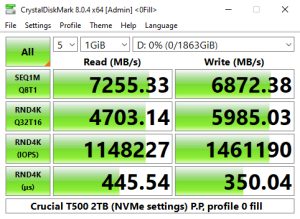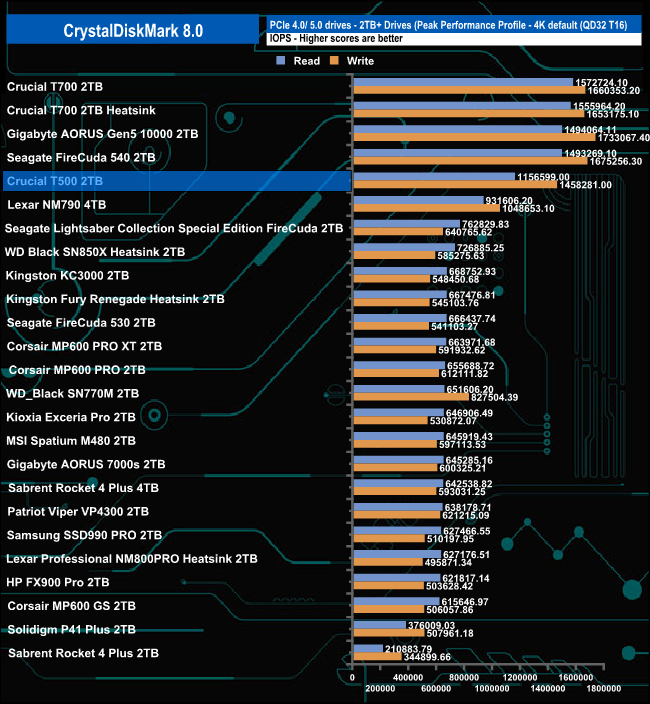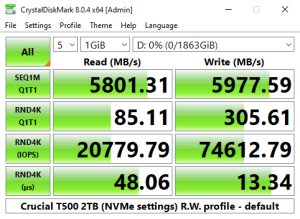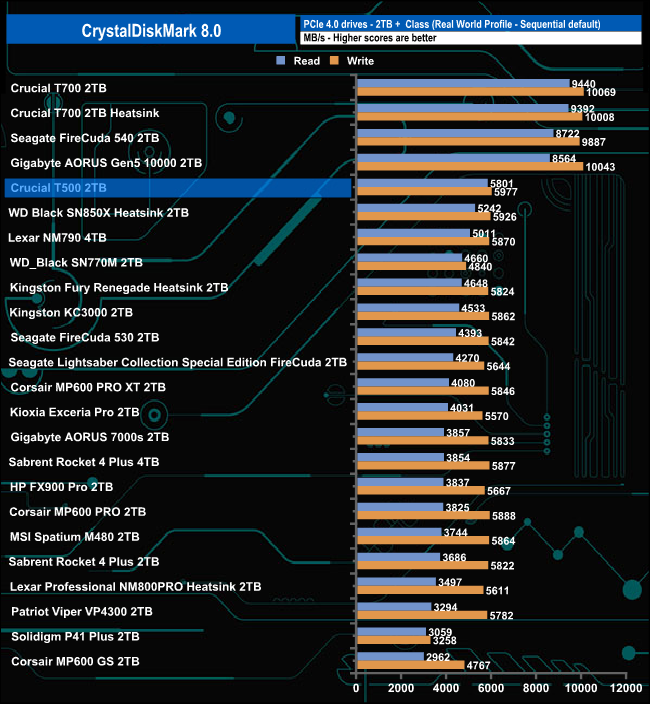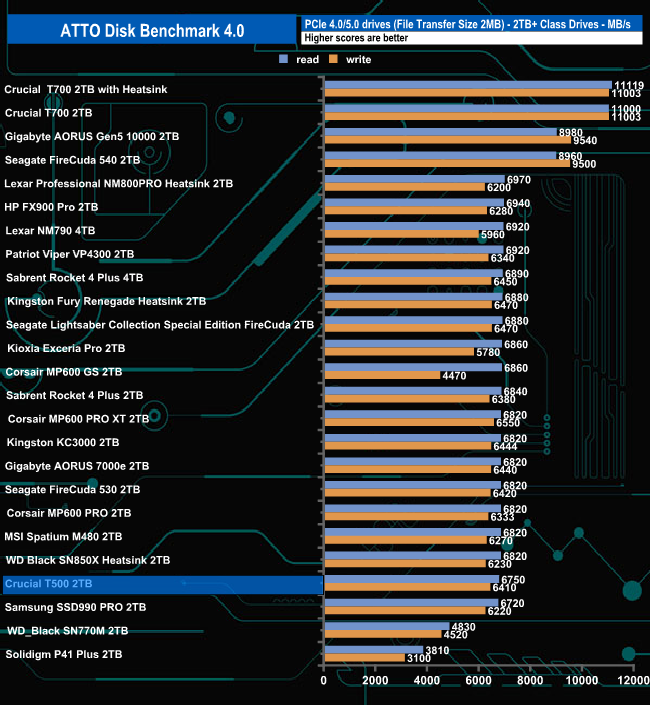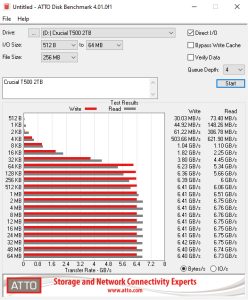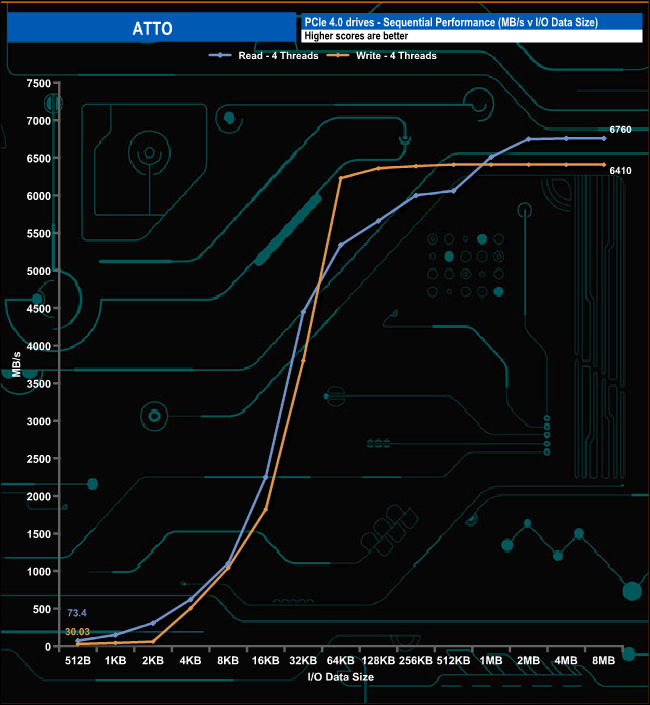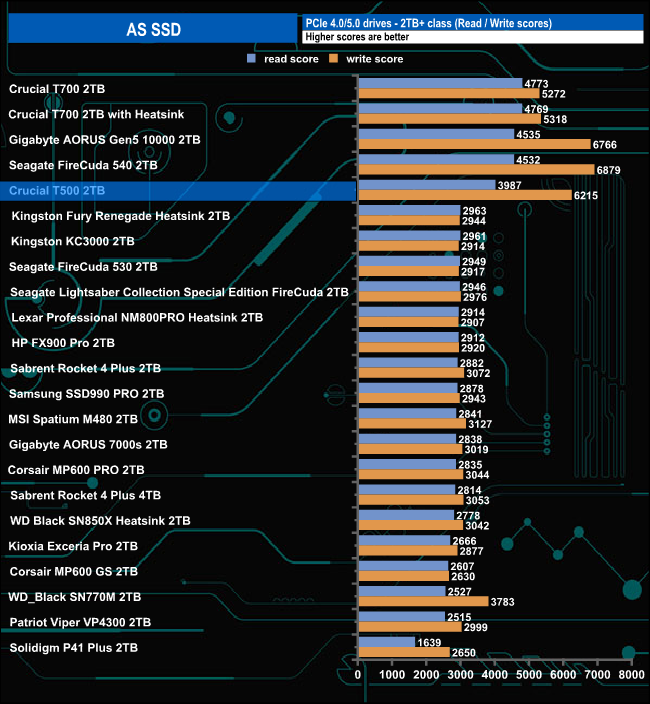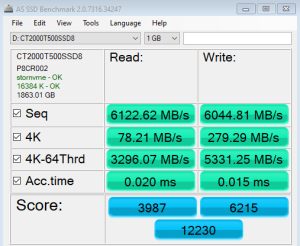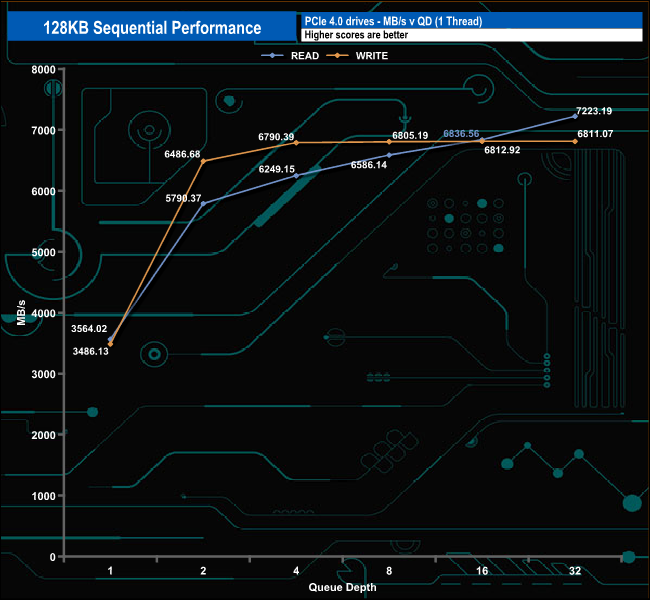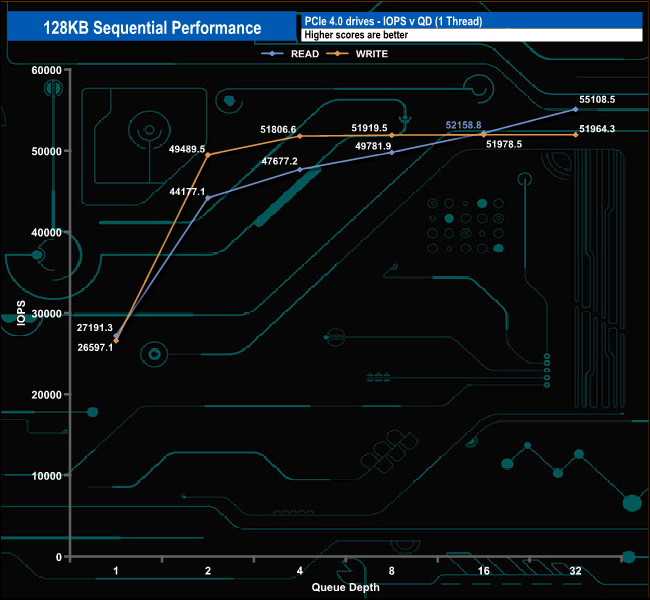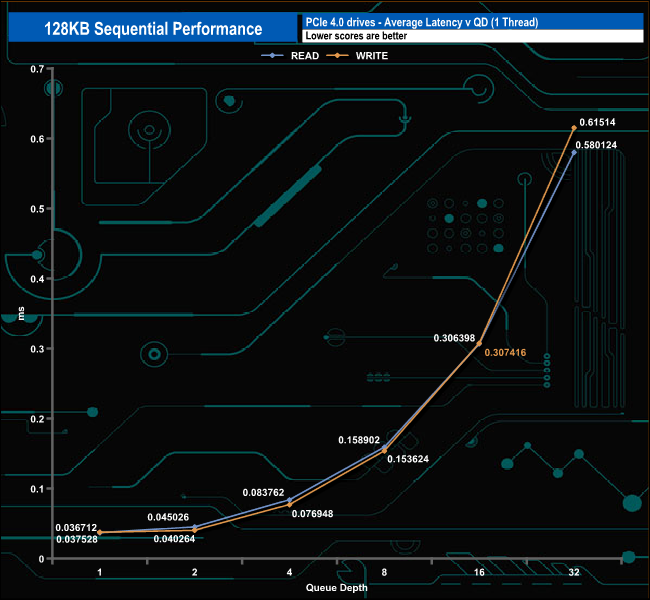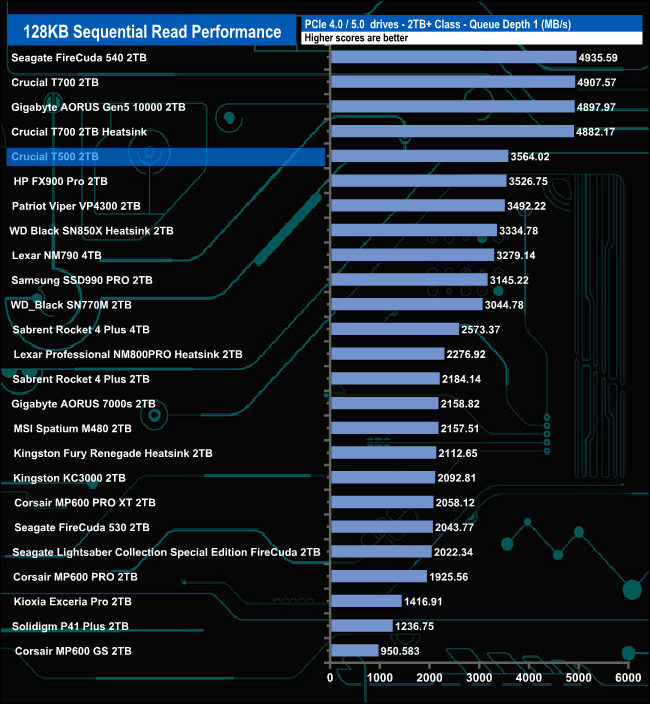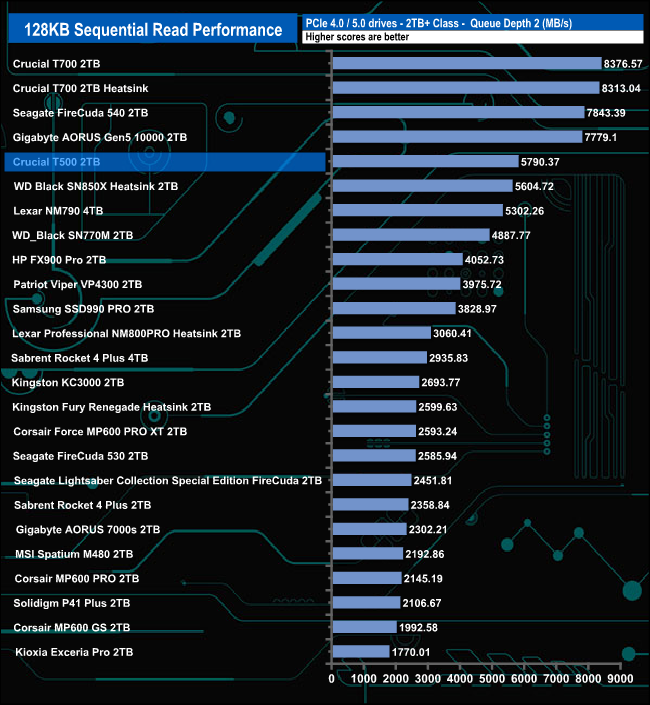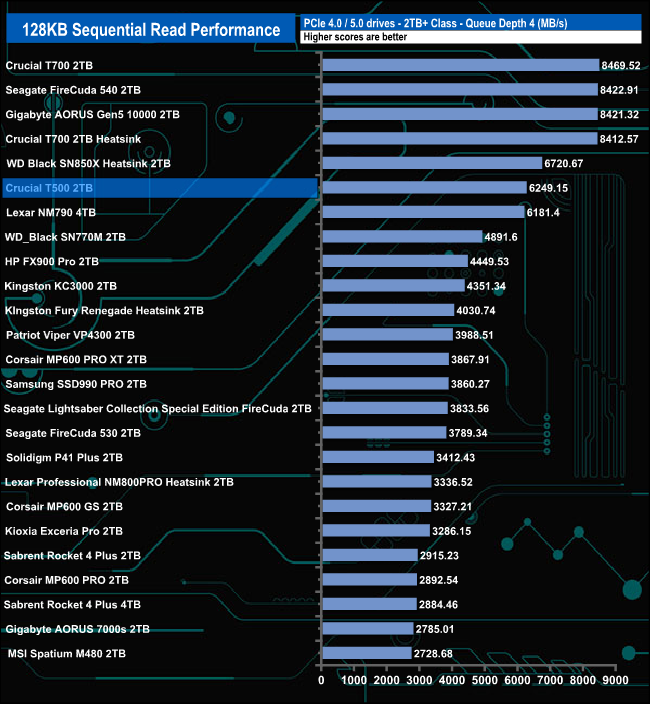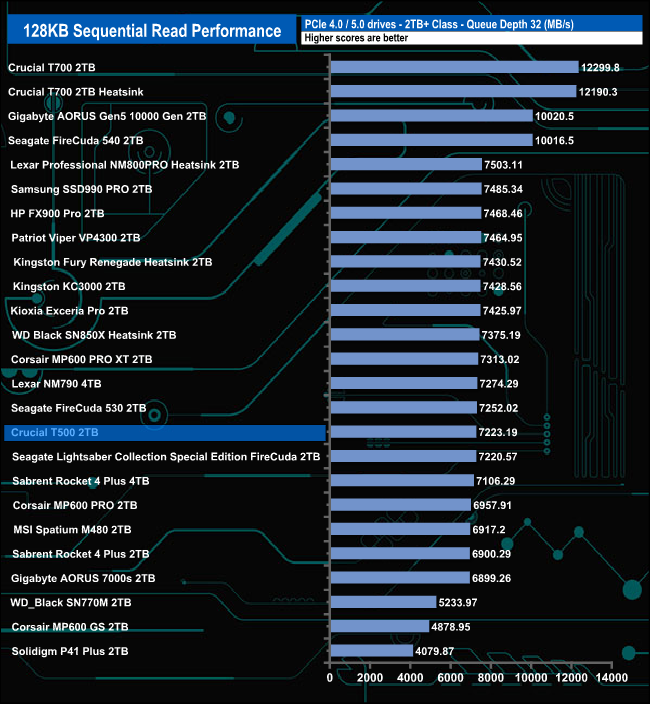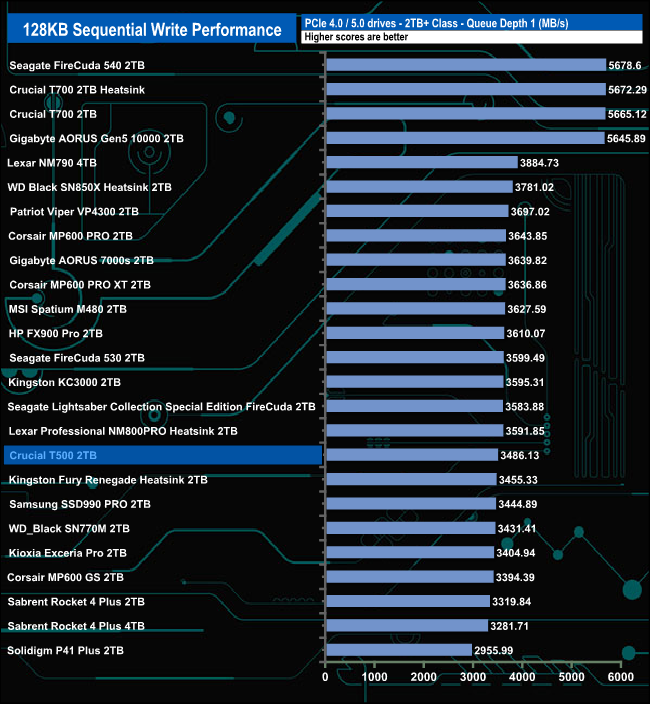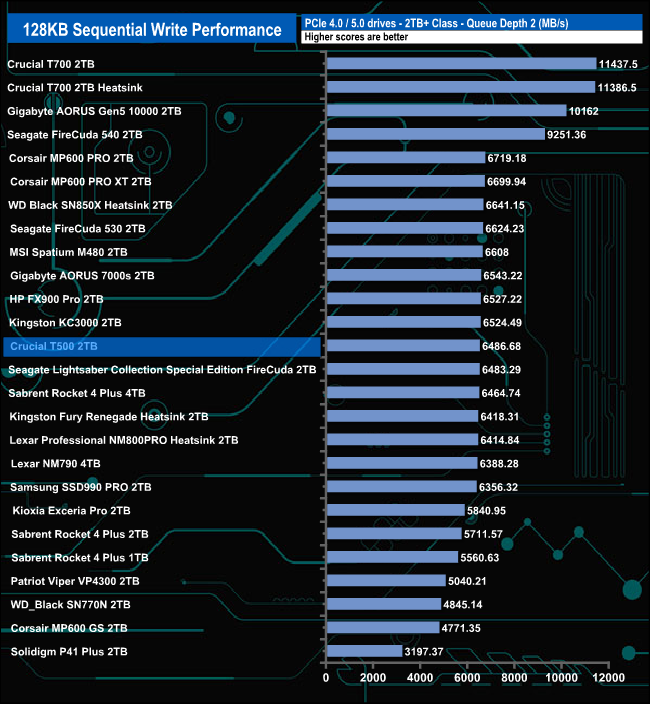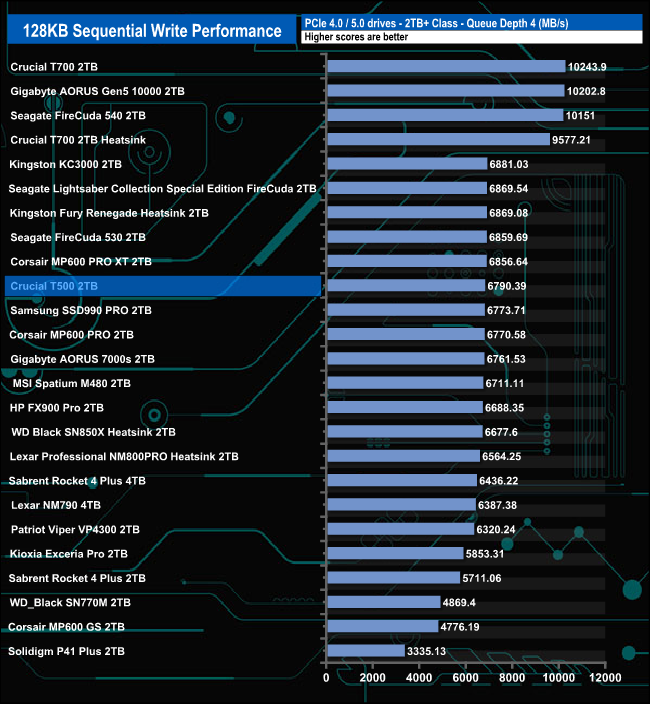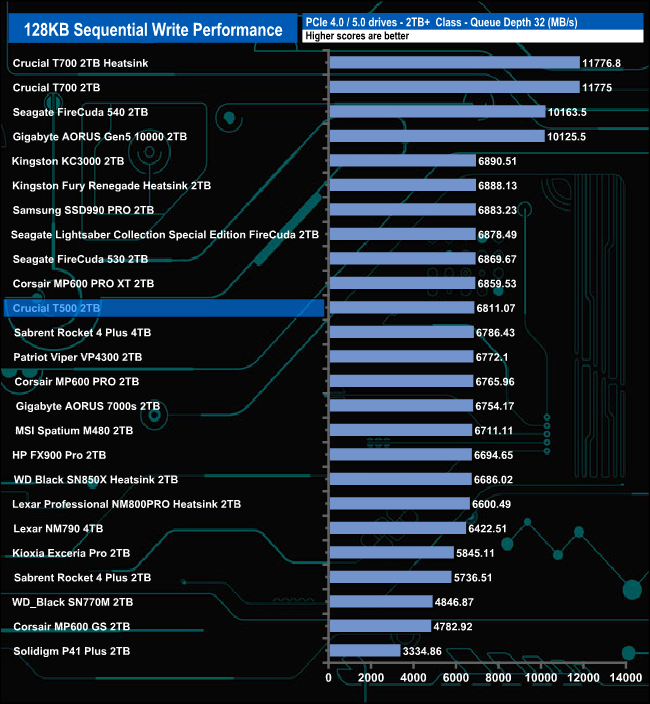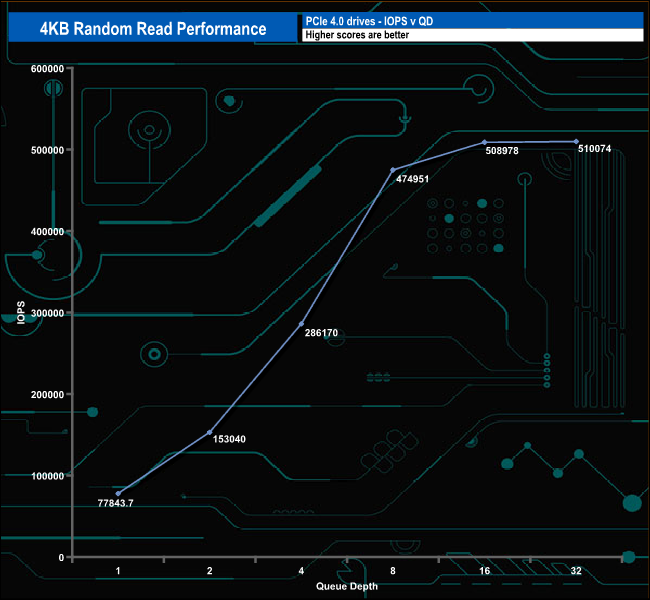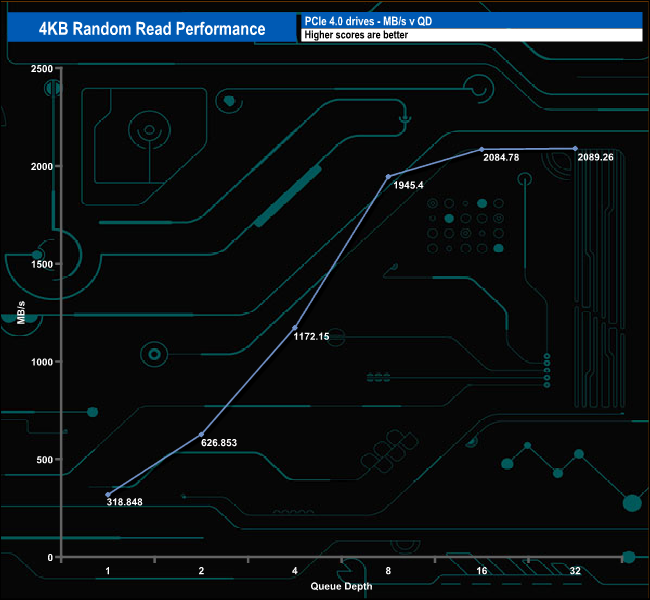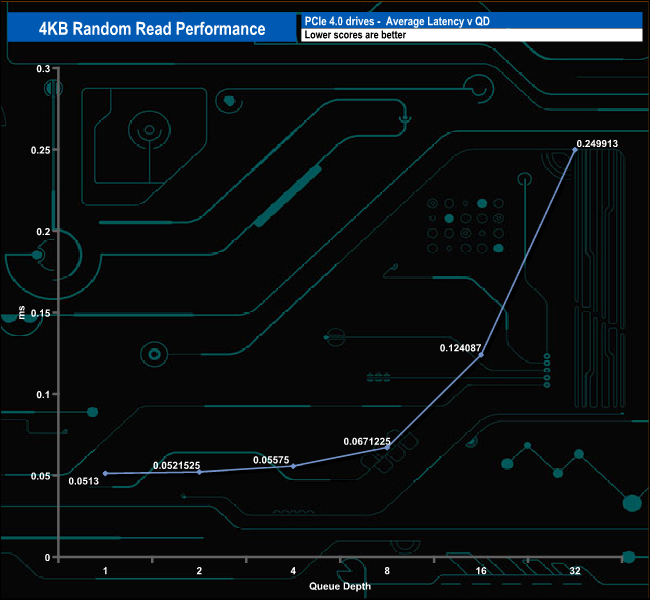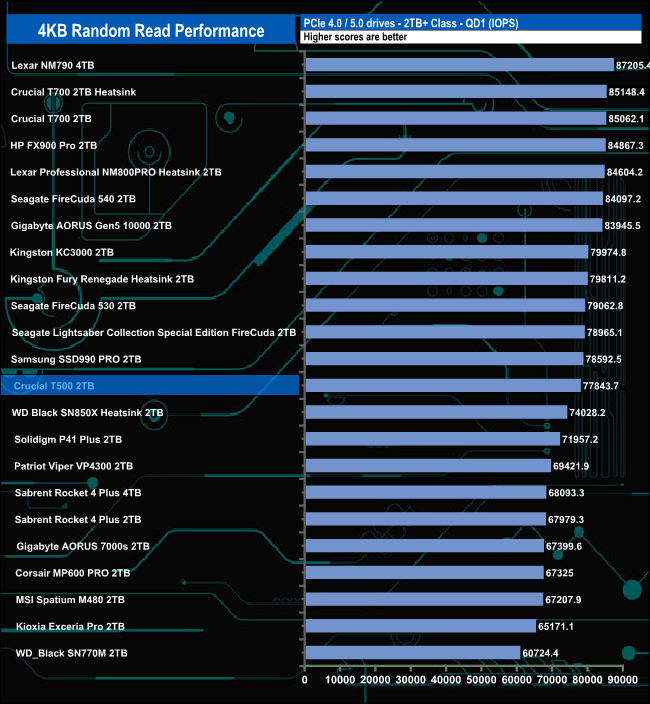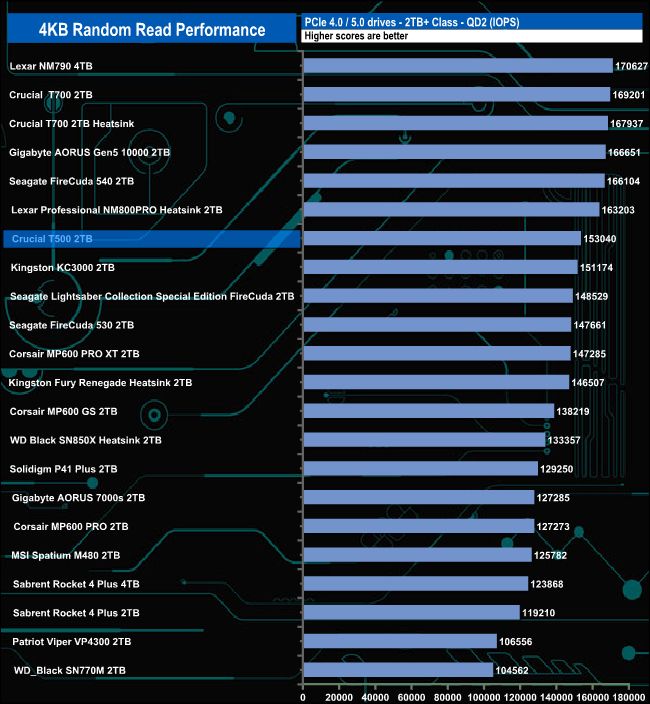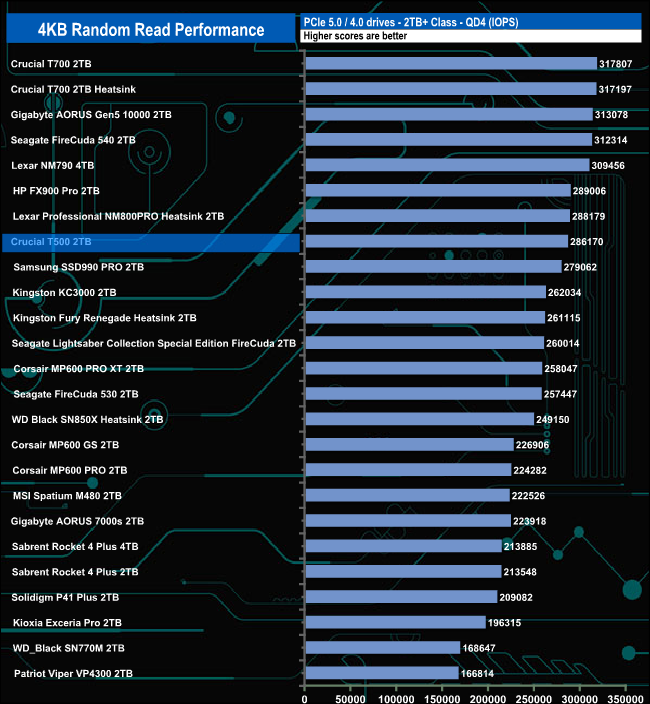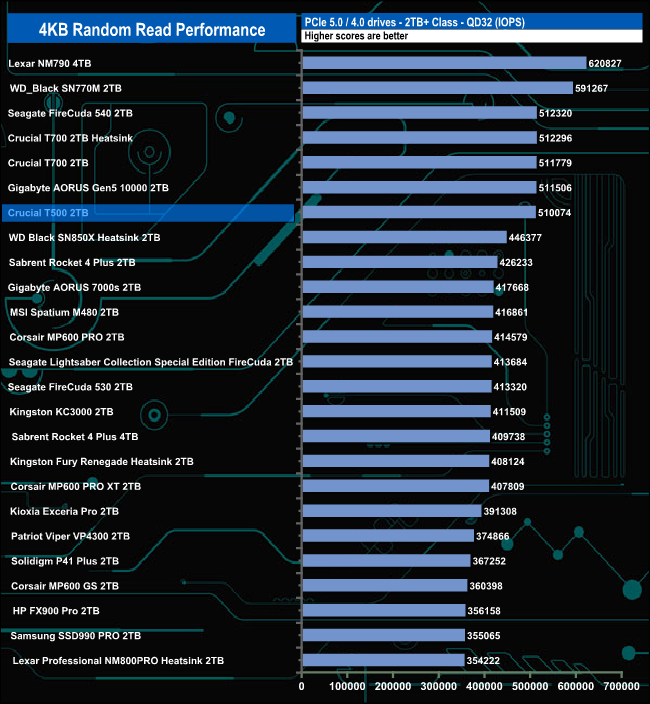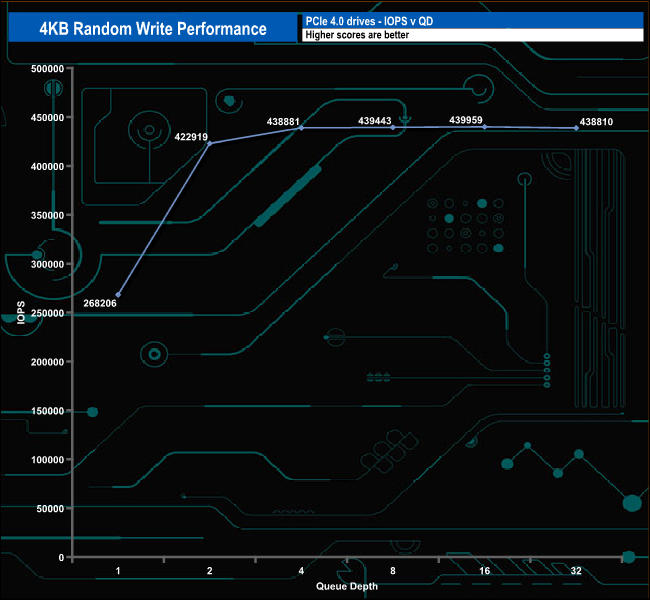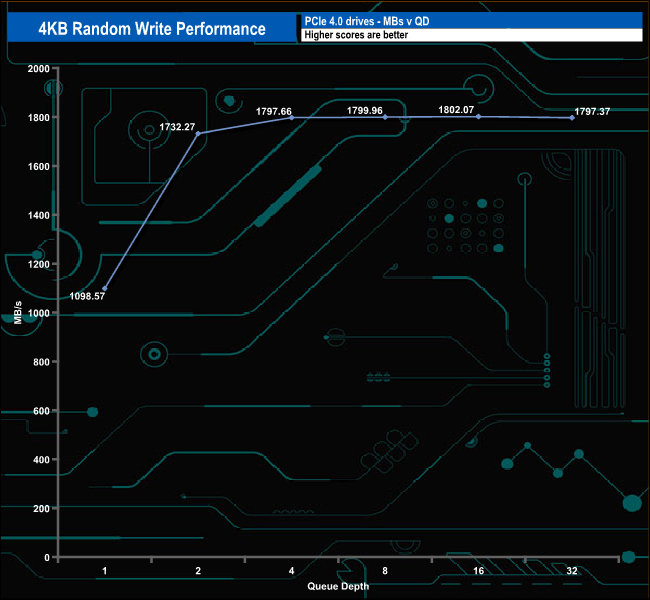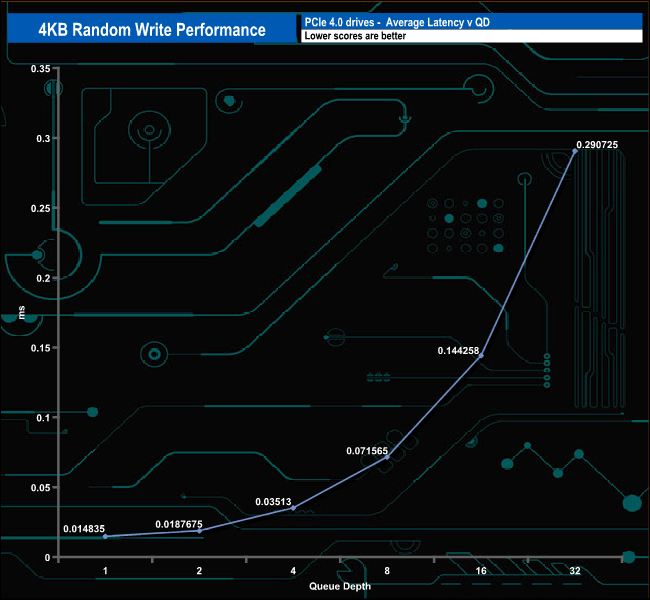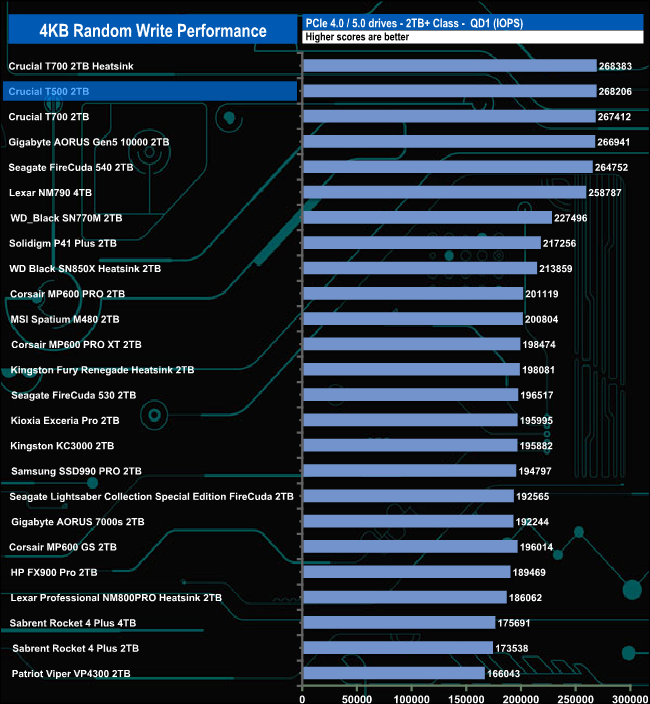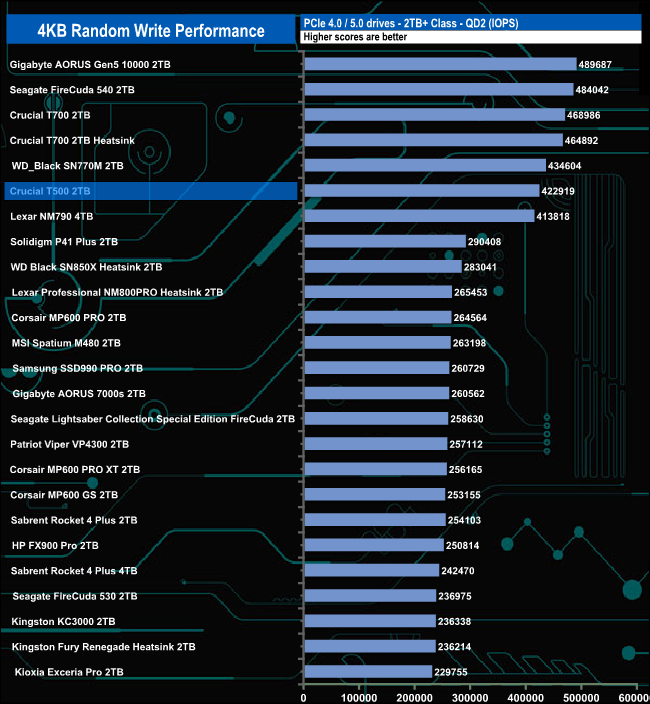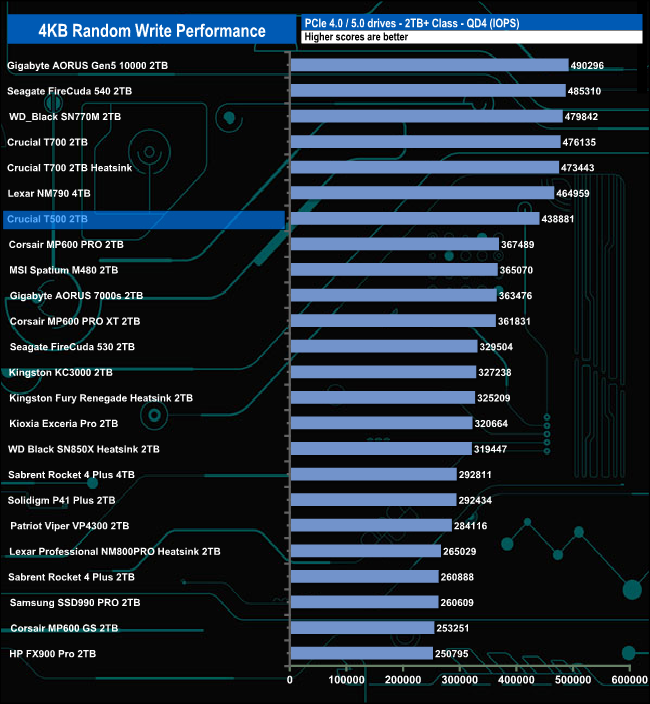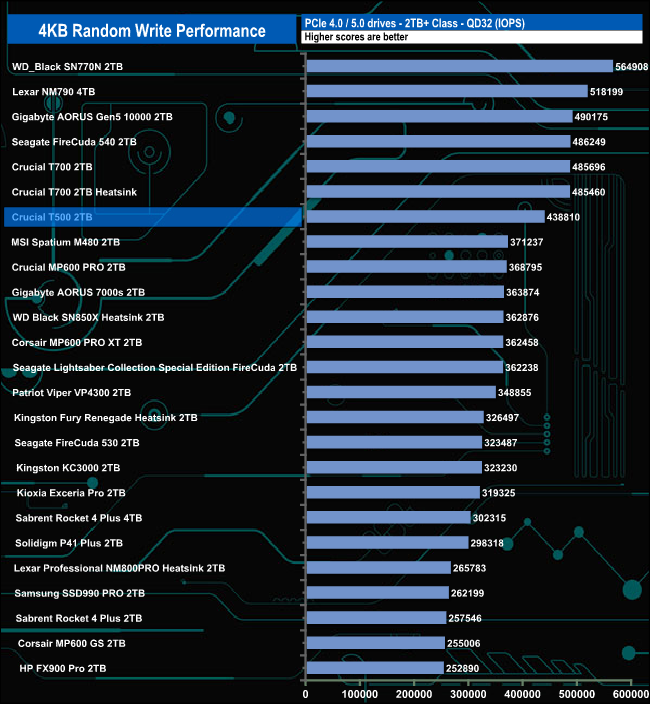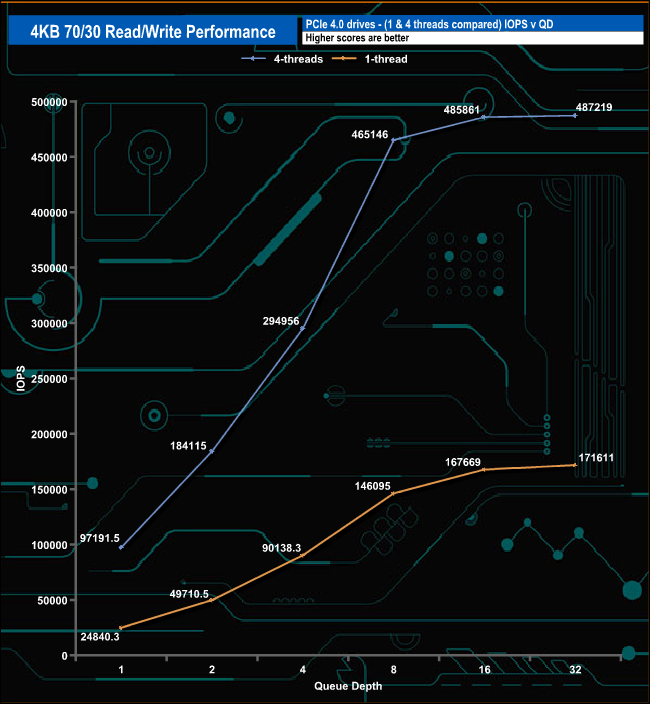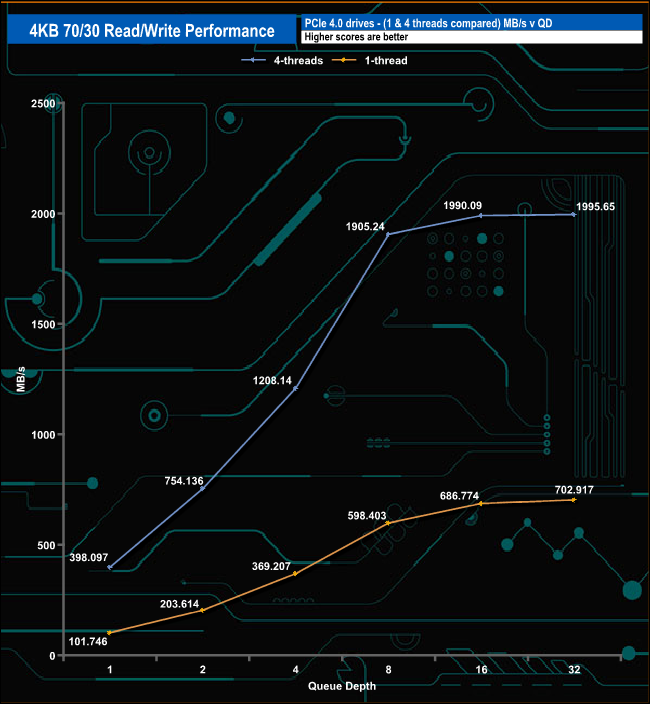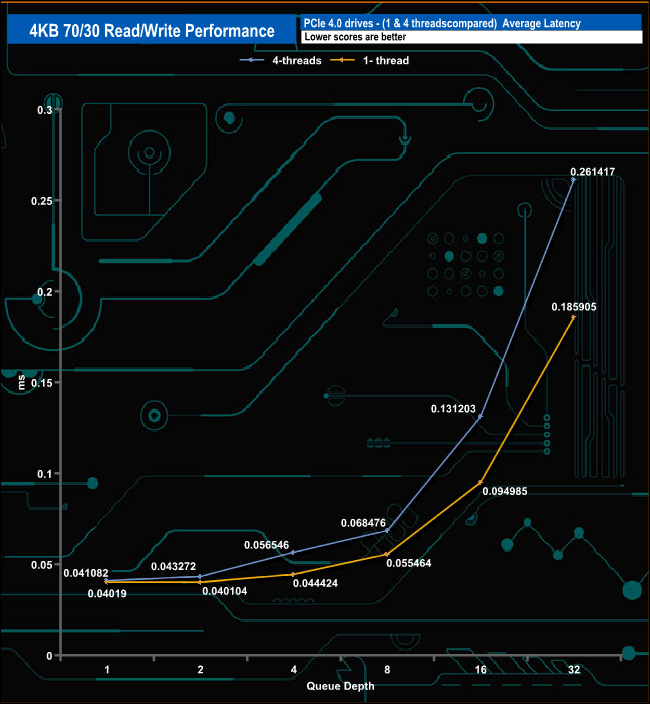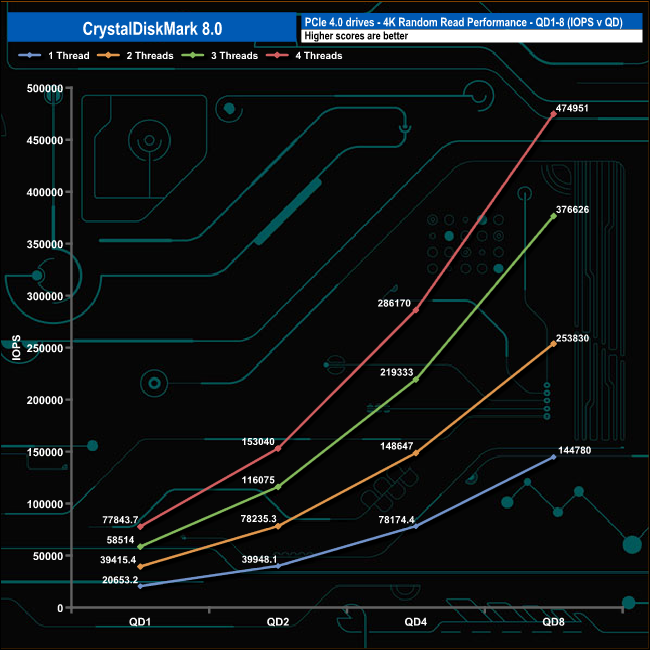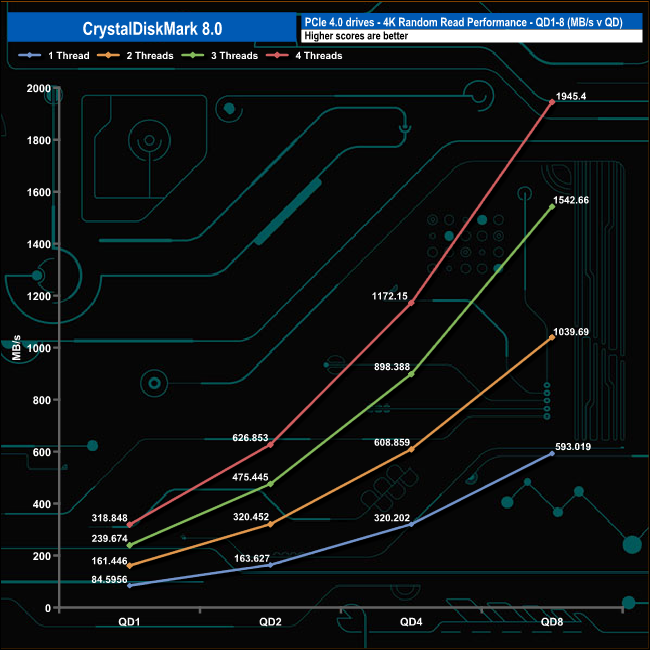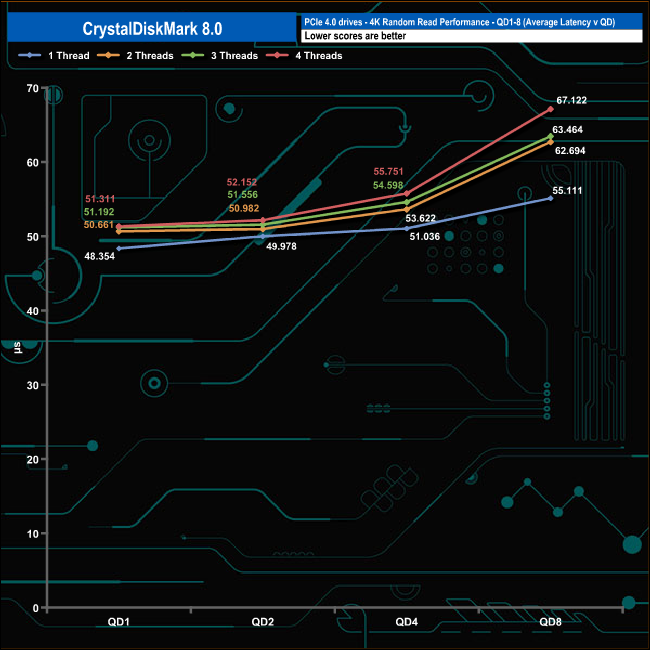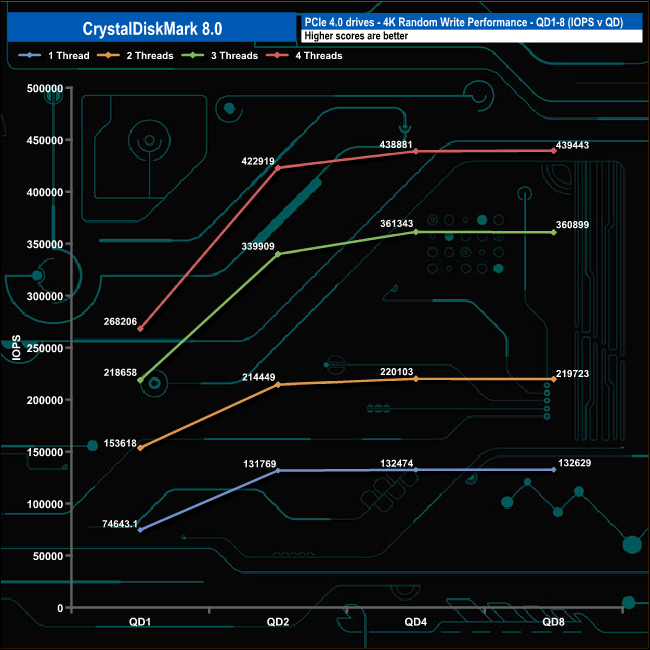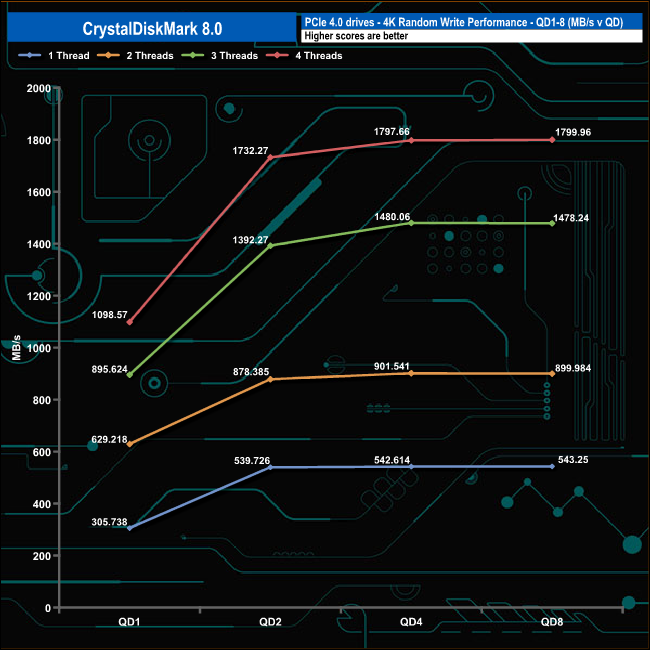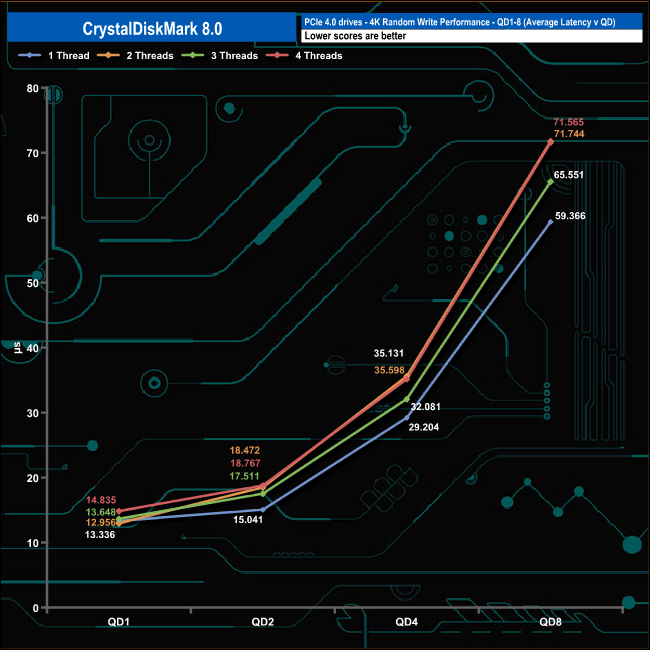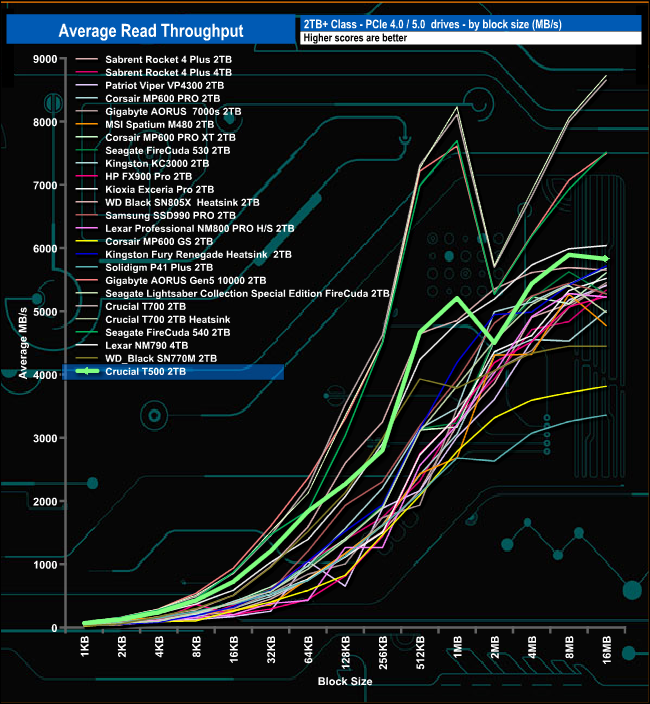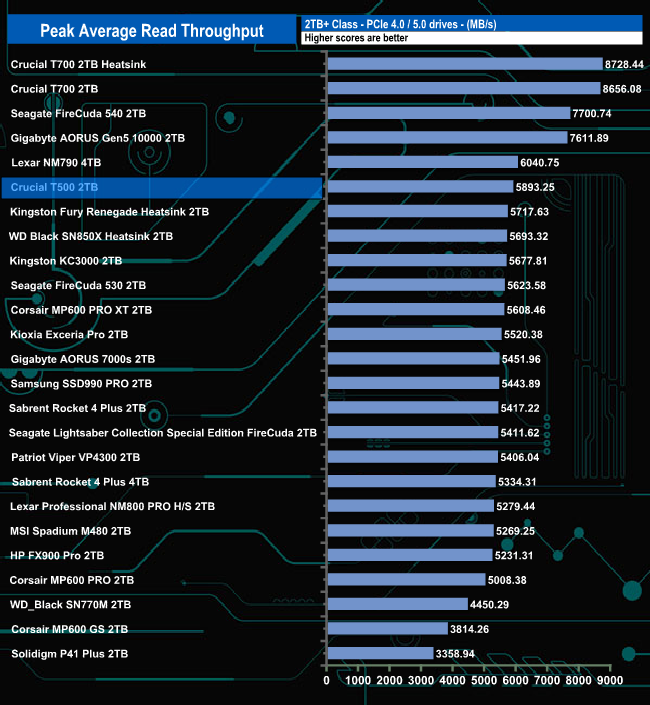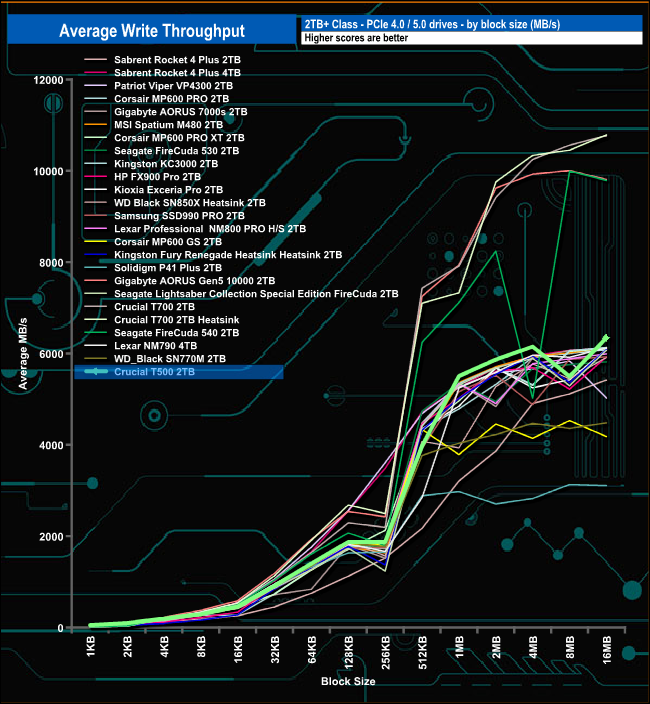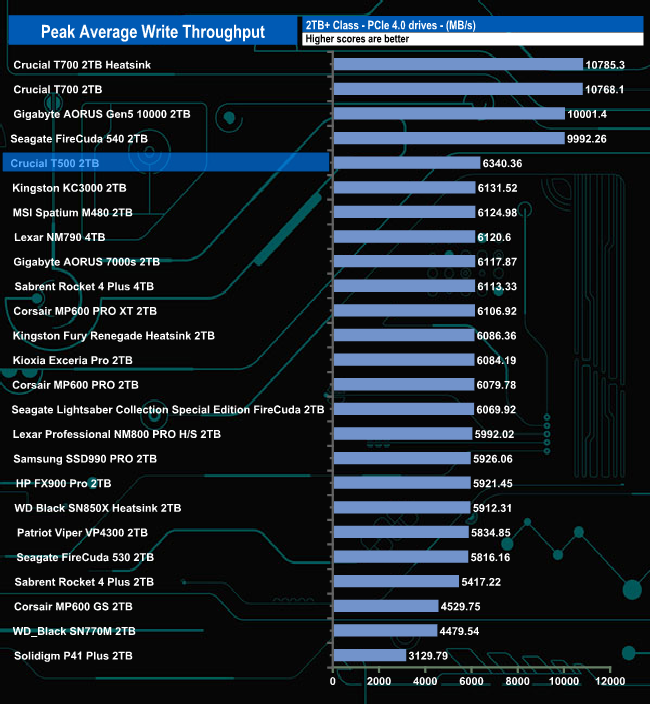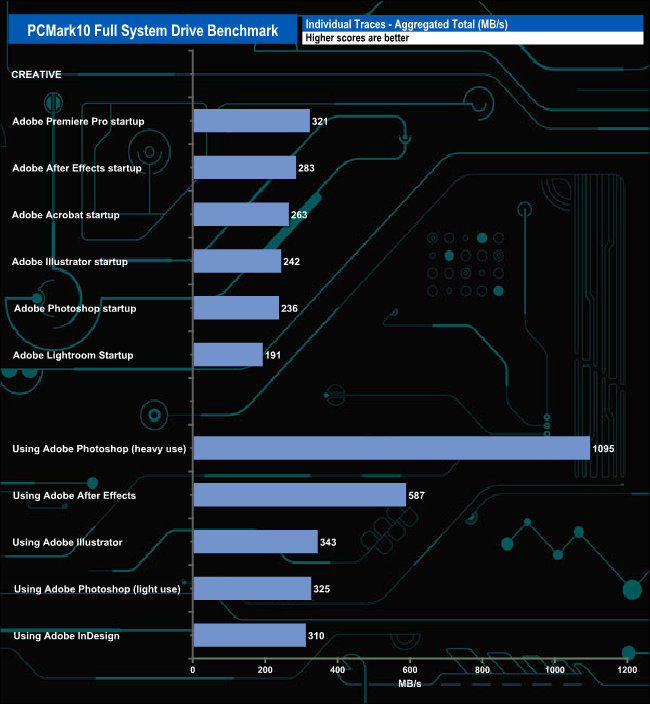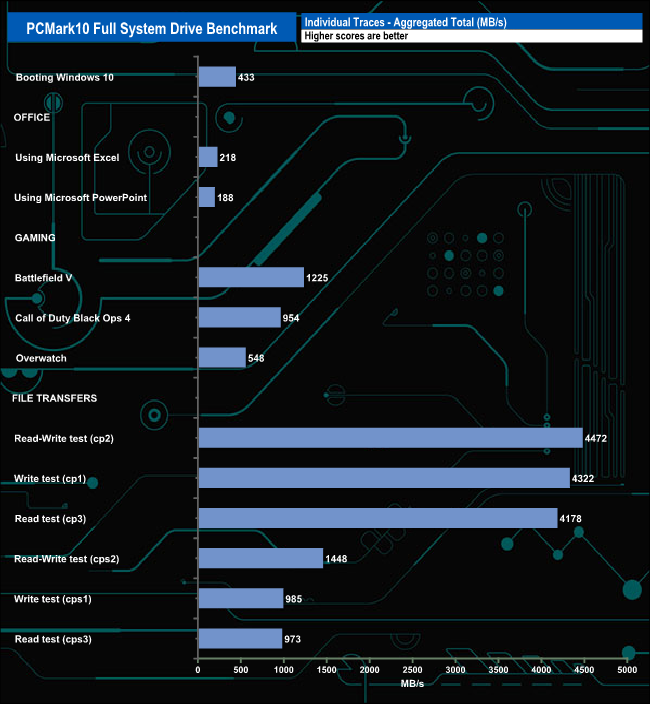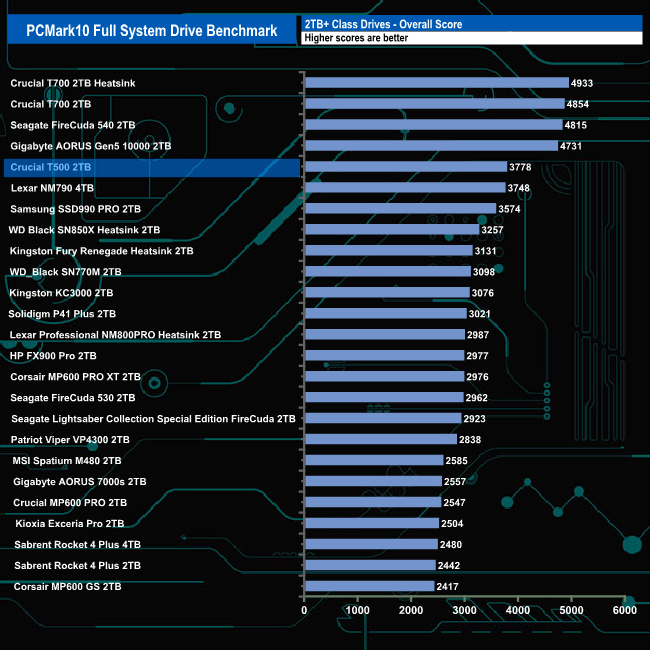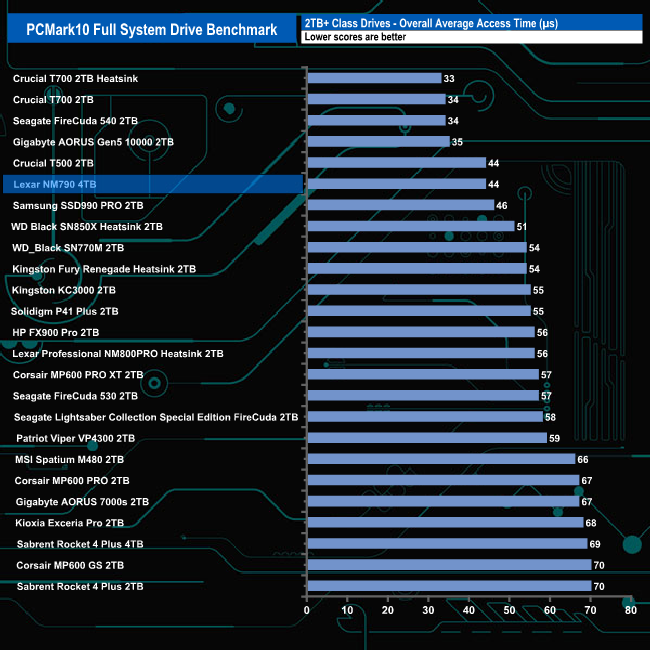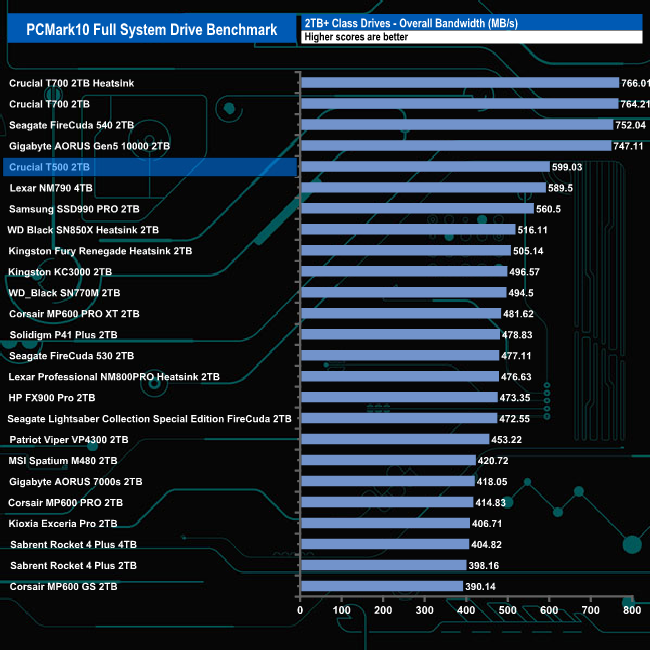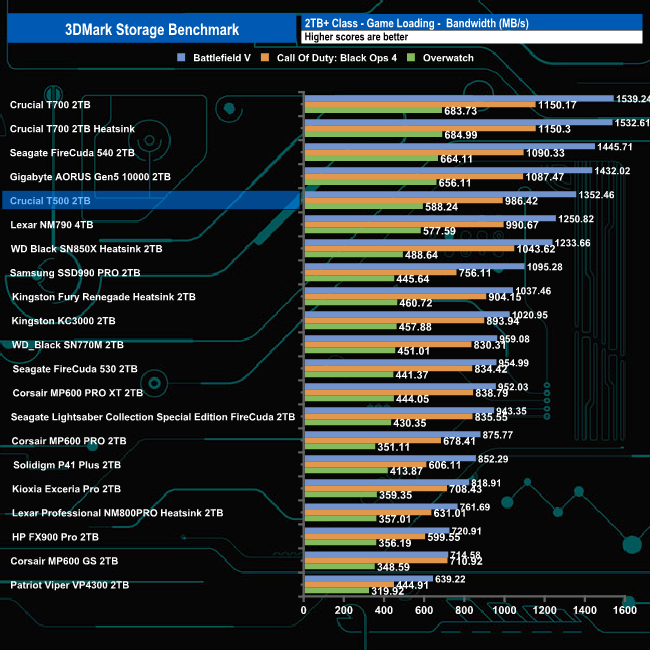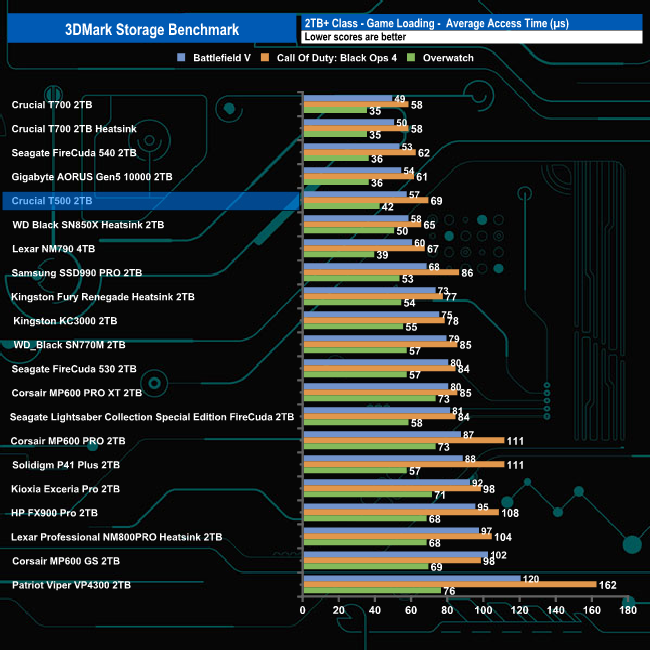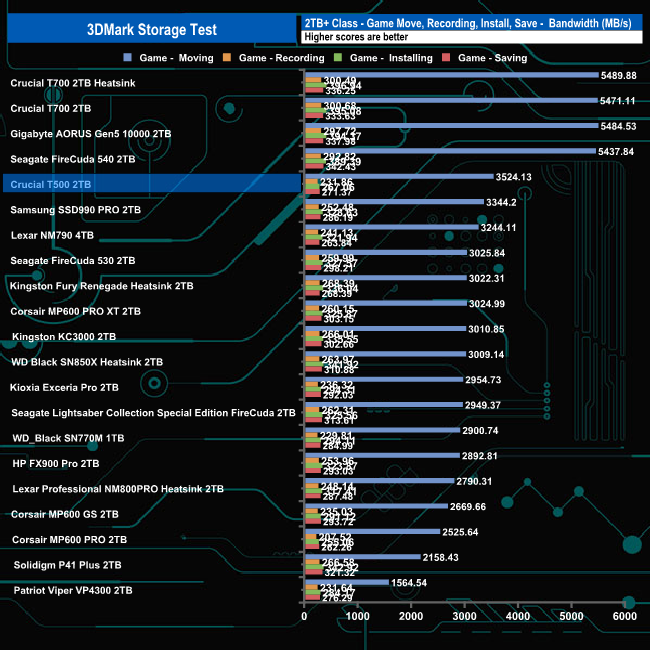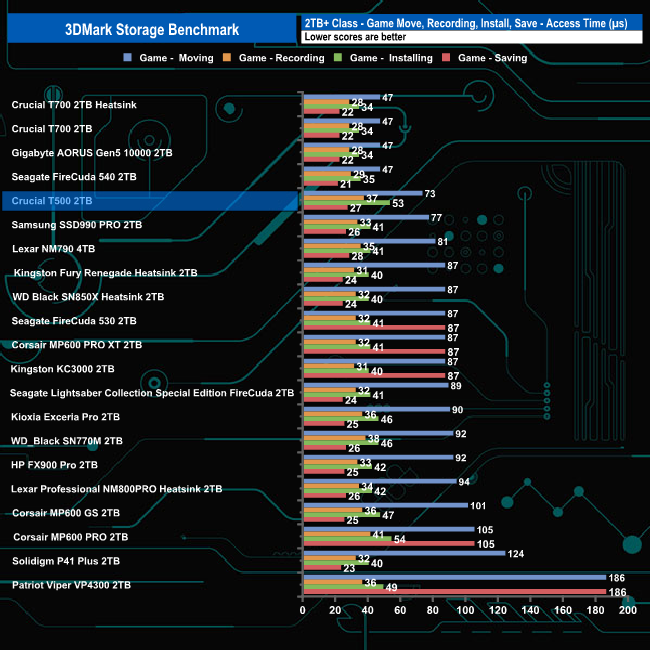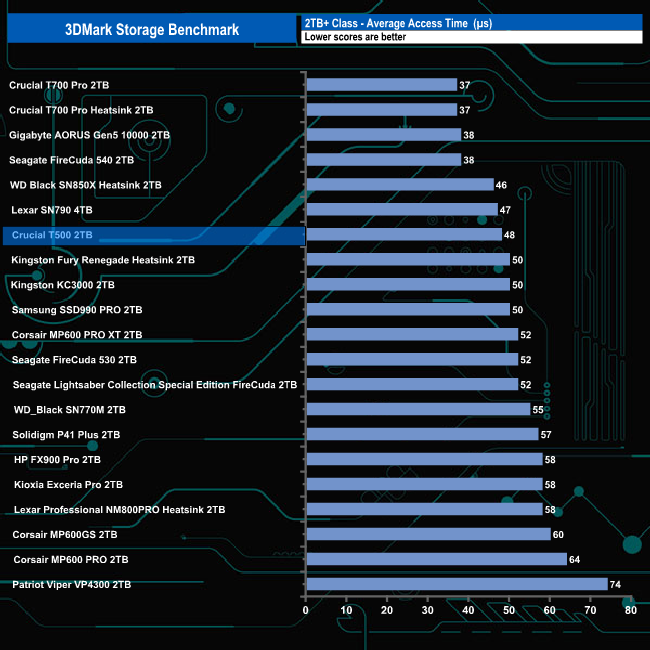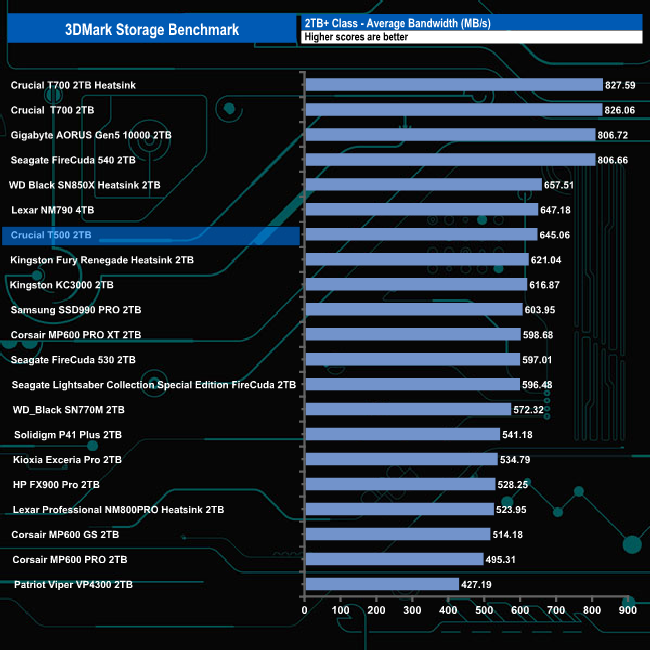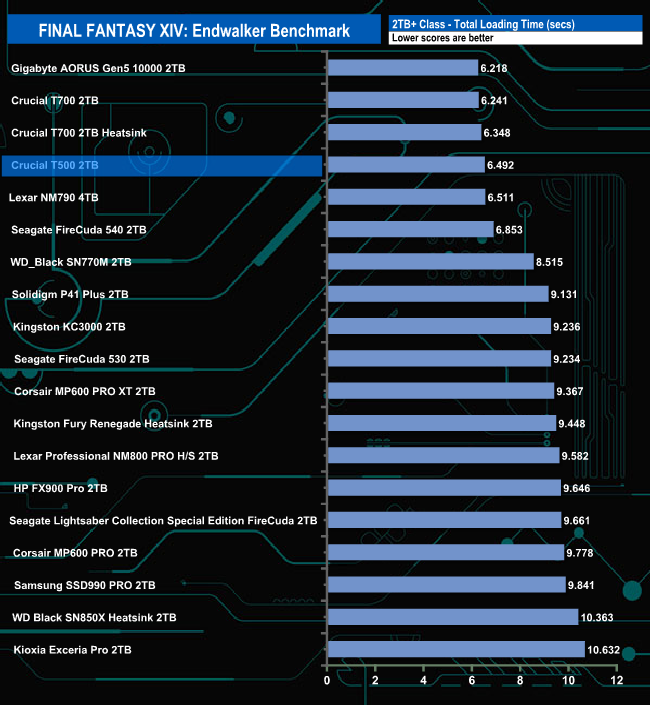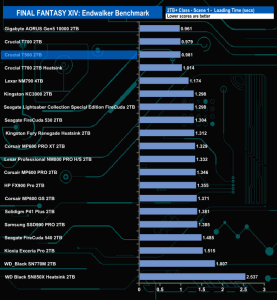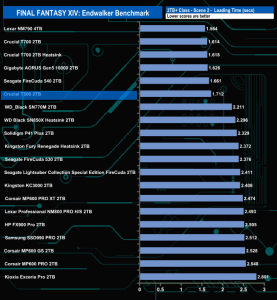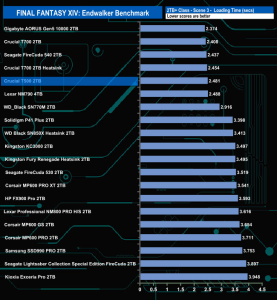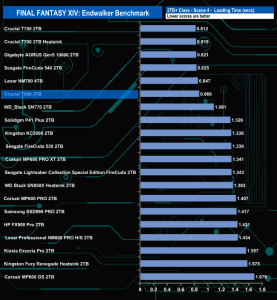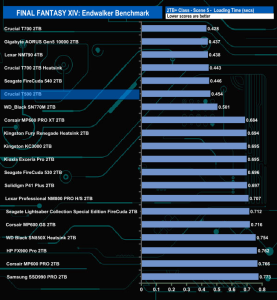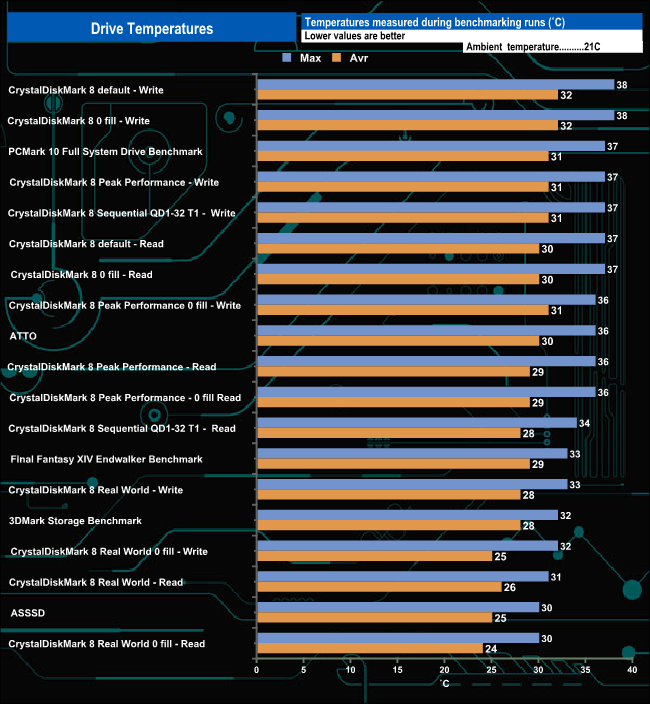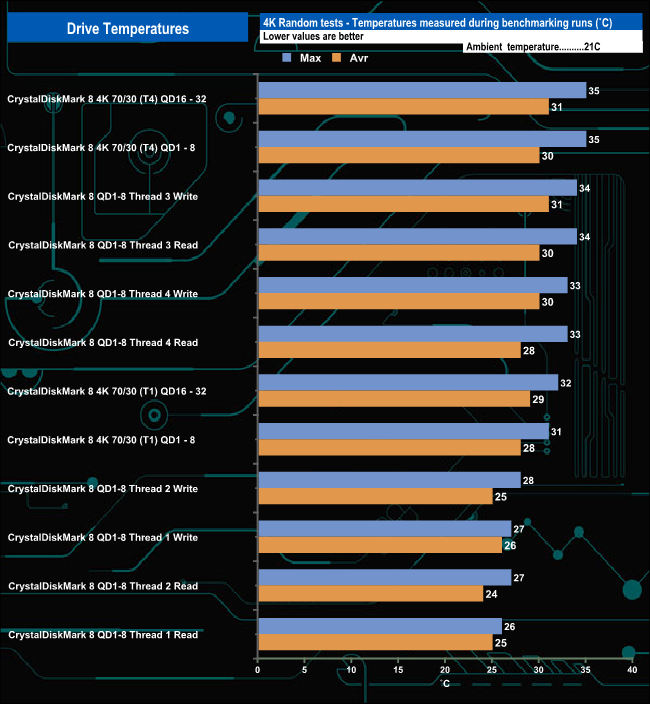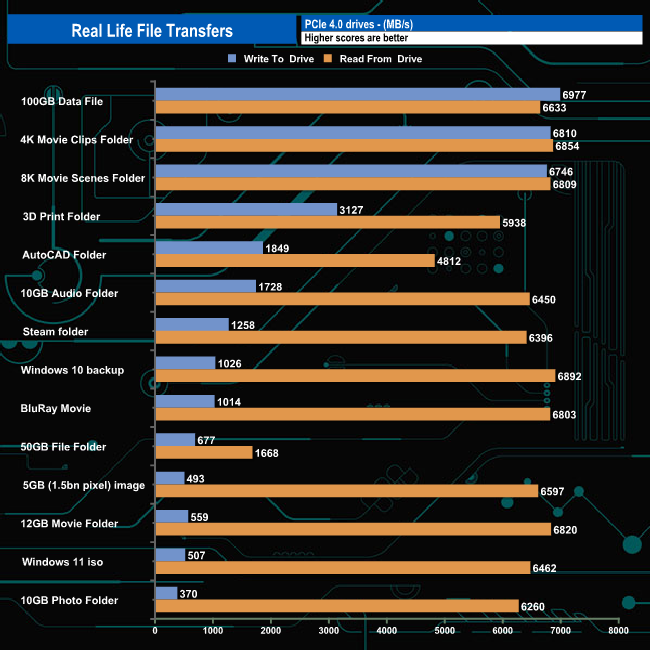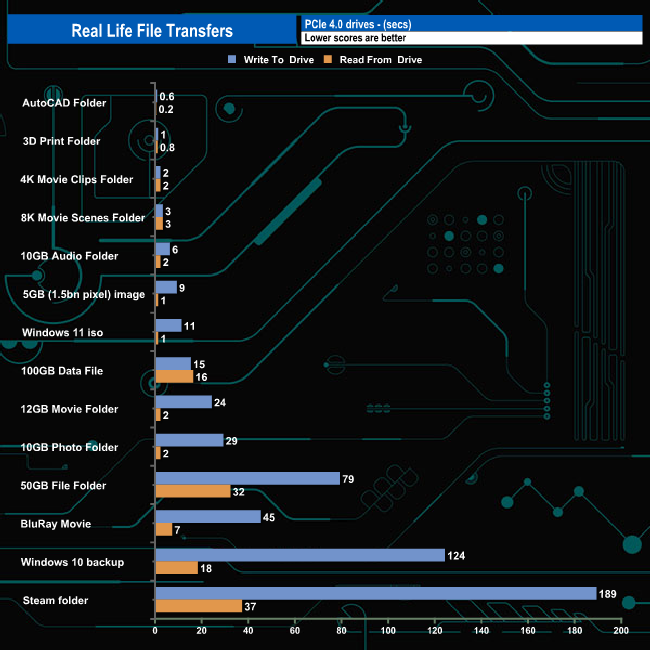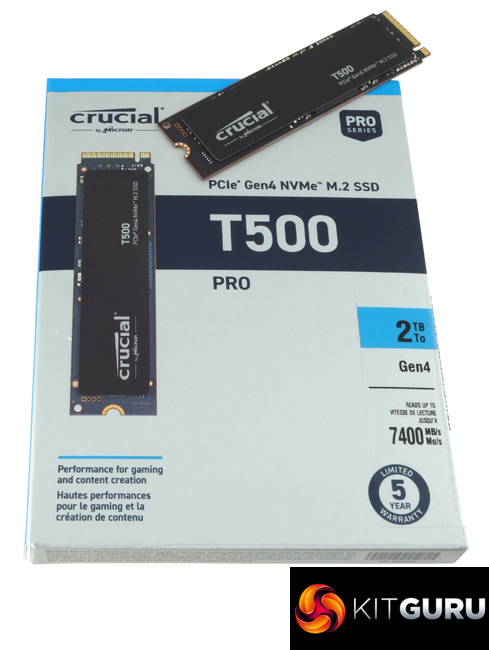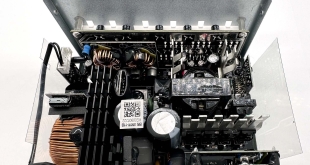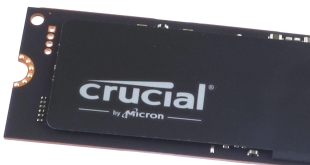
The latest addition to Crucial's range of NVMe SSDs is the T500. Part of Crucial's Pro range, the T500 combines a Phison controller and 232-layer 3D TLC NAND to create Crucial's fastest Gen 4 drive to date.
At launch the T500 family comprises three capacities, 500GB, 1TB and a flagship 2TB drive, which we are reviewing today. Crucial state there will be a 4TB drive coming in 2024. It is also available in two versions, a plain vanilla one (all three models) and one with an integrated heatsink (1TB and 2TB models only).
The T500 uses a Phison PS5025-E25 controller which looks after Micron's own 232-layer 3D TLC NAND. The 2TB drive is officially rated as up to 7,400MB/s and 7,000MB/s for Sequential read and writes respectively. The 500GB entry drive is rated as up to 7,200MB/s for reads and 5,700MB/s for writes while the 1TB drive gets figures of 7,300MB/s (reads) and 6,800MB/s (writes).
Random read performance is quoted as up to 800,000 IOPS for the 500GB drive, 1,150,000 IOPS for the 1TB drive and 1,180,000 IOPS for the 2TB model. The 2TB drive gets a random write rating of up to 1,440,000 IOPS as does the 1TB model. The 500GB drive gets a figure of up to 1,390,000 IOPS.
Endurance for the 2TB model is listed as 1,200TBW and Crucial backs the drive with a 5-year warranty.
Physical Specifications:
- Usable Capacities: 2TB.
- NAND Components: Micron 232-layer 3D TLC NAND.
- NAND Controller: Phison PS5025-E25.
- Cache: 2GB LPDDR4.
- Interface: PCIe Gen 4 x4.
- Form Factor: M.2, 2280.
- Dimensions: 22 x 80 x 2.3mm.
- Drive Weight: 7g.
- Firmware Version: P8CR002.
The T500 comes in a slim-line box with a good clear image of the drive on the front. To the right of this image is a longish sticker that displays the drive's capacity, maximum Sequential read speed (7,400MB/s) and a logo stating the 5-year warranty. The rear of the box is home to some multi-lingual notes about the drive's speed and backward compatibility.
Crucial's 2TB T500 is built on a single-sided M.2 2280 format.
As the 2TB T500 is a single-sided design, all the components are built on one side of the PCB. Next to the M.2 interface is the Phison PS5025-E25 controller, next is a 2GB Micron LPDDR4 DRAM IC (the T500 uses 1GB per 1TB of NAND flash) and finally two 1TB packages of Micron 232-layer (B58R) 3D TLC NAND.
At the time of writing this review, information about the Phison PS5025-E25 controller is a bit sketchy, to say the least. What is known is that the controller is designed to handle transfer speeds of up to 7,200MB/s, which is 200MB/s faster than the current Phison E18 controller.
Micron's 232-layer NAND has a few world firsts to its name. For starters, it is the world's first NAND to market sporting that many layers and is also the first TLC production NAND to use six-planes, the most planes per die of any TLC NAND. The NAND uses a 1.5mm x 13.5mm package making it the smallest high-density NAND available (at the time of writing).
Crucial’s Storage Executive is a pretty comprehensive SSD toolkit. With it, you can check the drive’s S.M.A.R.T data, update the firmware, see how the drive’s capacity is being used, monitor the drive’s operating temperature and overall health as well as adjust the Over Provisioning. There are a few more options as well that aren't supported by this particular drive.
For testing, the drives are all wiped and reset to factory settings by HDDerase V4. We try to use free or easily available programs and some real-world testing so you can compare our findings against your own system.
This is a good way to measure potential upgrade benefits.
Main system:
AMD Ryzen 7 7700X, 32GB DDR5-6000, Nvidia GeForce RTX 3050 and a Gigabyte AORUS X670E Xtreme motherboard.
Other drives
PCIe Gen5 2TB+
Crucial T700 2TB
Crucial T700 with Heatsink 2TB
Gigabyte AORUS 10000 2TB
Seagate FireCuda 520 2TB
PCIe Gen4 2TB+
Corsair MP600 GS 2TB
Corsair MP600 PRO 2TB
Corsair MP600 PRO XT 2TB
Gigabyte AORUS 7000e 2TB
HP FX900 Pro 2TB
Kingston Fury Renegade Heatsink 2TB
Kingston KC3000 2TB
Kioxia Exceria Pro 2TB
Lexar Professional NM800PRO Heatsink 2TB
MSI Spatium M480 2TB
Patriot Viper VP4300 2TB
Sabrent Rocket 4 Plus 2TB
Sabrent Rocket 4 Plus 4TB
Samsung SSD990 PRO 2TB
Solidigm P41 Plus 2TB
Seagate Lightsaber Collection Special Edition FireCuda 2TB
Seagate FireCuda 530 2TB
WD Black SN850X Heatsink 2TB
WD_Black SN770M 2TB
Software:
Atto Disk Benchmark 4.
CrystalMark 8.0.0.
AS SSD 2.0.
IOMeter.
UL Solutions PC Mark 10.
UL Solutions 3DMark Storage Benchmark.
Final Fantasy XIV Endwalker Official Benchmark.
CrystalDiskMark is a useful benchmark to measure the theoretical performance levels of hard drives and SSDs. We are using v8.0.
In CrystalDiskMark 8's 4K QD1 T1 test, the 2TB Crucial T500 sits inside the top 10 with a read speed of 85.16MB/s. However, its write speed of 306.03MB/s is more impressive, as it's the second fastest write speed we've seen for a Gen 4 drive to date, just behind the 4TB version of Lexar's MN790 drive.
As you can see from the benchmark result screens the drive fell just short of the official maximum Sequential read/write figures for the 2TB drive of 7,400MB/s and 7,000MB/s for Sequential read and writes respectively, with test figures of 7,259MB/s for reads and 6,866MB/s for writes.
Those Sequential results see the drive in the bottom half of the results chart.
Peak Performance Profile.
Using the Peak Performance profile of the CrystalDiskMark benchmark we were once again a little short of the maximum official Sequential performance figures.
Looking at the benchmark screens we couldn't quite hit the official random read figure of 1,180,000 IOPS with a test result of 1,156,599 IOPS but we could at least confirm the random write figure, the tested 1,458,281 IOPS was even a little faster than the official 1,440,000 IOPS.
Using CrystalDiskMark 8's Real World profile, the T500 produced read and write scores of 5,801MB/s and 5,977MB/s, which are the fastest we've seen to date in this test for a 2TB Gen 4 drive.
The ATTO Disk Benchmark performance measurement tool is compatible with Microsoft Windows. Measure your storage system performance with various transfer sizes and test lengths for reads and writes. Several options are available to customize your performance measurement including queue depth, overlapped I/O and even a comparison mode with the option to run continuously.
Use ATTO Disk Benchmark to test any manufacturer's RAID controllers, storage controllers, host adapters, hard drives and SSD drives and notice that ATTO products will consistently provide the highest level of performance to your storage.
We are using version 4.1 for our NVMe disk tests.
Using the ATTO benchmark, we couldn't hit the official maximum figures of 7,400MB/s for reads and up to 7,000MB/s for writes with test results of 6,750MB/s and 6,410MB/s for reads and writes respectively.
Using the ATTO benchmark writes begin to plateau out at the 512KB mark with a figure of 6,410MB/s. Reads begin to level off after the 2MB mark at 6,750MB/s.
AS SSD is a great free tool designed just for benching Solid State Drives. It performs an array of sequential read-and-write tests, as well as random read-and-write tests with sequential access times over a portion of the drive. It uses incompressible data samples which many drives struggle with, so results can be viewed as the worst case scenarios.
AS SSD includes a sub suite of benchmarks with various file pattern algorithms but this is difficult in trying to judge accurate performance figures.
With an AS SSD read score of 3987, the 2TB T500 is the fastest Gen 4 consumer drive we've seen to date. However, its write score of 6215 is even more impressive as it's the third fastest score we've seen to date for any 2TB NVMe consumer drive regardless of interface.
We used CrystalDiskMark 8‘s custom settings to test the Sequential read and write performance of the drive through a range of queue depths. The setup for the tests is listed below.
128KB Sequential Read / Write.
Transfer Request Size: 128KB, Thread(s): 1, Outstanding I/O: 1-32.
In this test, we couldn't quite hit the official maximum Sequential read and write speeds of 7,400MB/s and 7,000MB/s respectively with a best-read result of 7,223.19MB/s and a best-write figure of 6,811.07MB/s.
128KB Sequential Read v QD compared
At QDs 1 and 2, the T500 is the fastest Gen 4 drive we've seen to date. At QD 4 it slips behind WD's Black SN850X heatsink drive and at QD32 it lies in a low middle position in the results table.
128KB Sequential Write v QD compared
At QD1 the drive sits in the lower half of the Sequential write results chart. QDs 2, 4 and 32 see the drive climb to a mid-table position.
We used CrystalDiskMark 8‘s custom settings to test the 4K random read performance of the drive through a range of queue depths. The setup for the tests is listed below.
Transfer Request Size: 4KB, Outstanding I/O: 1-32.
With our 4-threaded random 4K read testing we couldn't get close to the official rating of 1,180,000 IOPS with a best test result of 510,074 IOPS.
4K Random Read v QD Performance.
At QD1 the 2TB Crucial T500 sits in a mid-table position, however, at QD's 2, 4 and 32 it moves up to lie in the top 10 of drives tested to date.
We used CrystalDiskMark 8‘s custom settings to test the 4K random write performance of the drive through a range of queue depths. The setup for the tests is listed below.
Transfer Request Size: 4KB, Outstanding I/O: 1-32.
As with our 4-threaded random 4K read testing, we couldn't get close to the official rating of 1,440,000 IOPS in our random write tests. The best we saw was 439,959 IOPS (1,802.07MB/s) at QD16. The drive finished the test run at QD32 with the performance dropping off slightly at 438,810 IOPS (1,797.37MB/s).
4K Random Write v QD Performance.
While we couldn't get close to the official maximum 4K write rating for the drive, at QD1 it's the fastest Gen4 drive we've seen to date when it comes to 4K random writes. Its score of 268,206 IOPS manages to split the two Gen5 Crucial T700 drives and sit in second place in the results chart. It doesn't last though because as the queue depth deepens, the drive drops slowly down the chart.
We used CrystalDiskMark 8’s custom settings to test the 4K 70/30 mixed read/write performance of the drive through a range of queue depths using a single thread and four threads.
Using four threads in our 70/30 read/write tests, the performance of the 2TB Crucial T500 ranges from 97,191 IOPS (398.09MB/s) at QD1 to 487,219 IOPS (1,995MB/s) at QD32. With a single thread, the performance ranges from 24,840 IOPS (101.74 MB/s) at QD1 up to 171,611 IOPS (702.917MB/s) at QD32.
We used CrystalDiskMark 8 to test the random performance of the drive at lower queue depths (QD1 – QD8 where most of the everyday workloads occur) using 1 to 4 threads.
Random Reads
In this test, the drive displayed smooth performance as the queue depth deepened. At QD1 the drive performance ranges from 20,653 IOPS (84,5956MB/s) using a single thread through to 77,843 IOPS (318.84MB/s) with four threads.
Random Writes
In the 4K write tests, the performance rose quickly from QD1 to QD2 for all four tested threads with the fastest rise seen in the three and four threaded tests. After QD2 all four threads see the performance begin to plateau out. It is more pronounced in the tests using one and two threads.
In our read-throughput test, the drive peaked at the 8MB block mark at 5,893.25MB/s before finishing the test run with a slightly slower 5,829.58MB/s. Both of these figures however are not close to the official maximum figure of 7,400MB/s.
The peak read figure of 5,893.25MB/s sees it sitting in sixth place in the results chart, making it the second fastest Gen4 drive in this test after Lexar's NM790.
In the write throughput tests, the drive peaked at the end of the test run at 6,340.36MB/s. As with the read result, this is some way off the official maximum rating of 7.000MB/s.
The test result of 6,340MB/s makes the drive the fastest Gen4 drive we have seen in this particular test to date.
The PCMark 10 Full System Drive Benchmark uses a wide-ranging set of real-world traces from popular applications and common tasks to fully test the performance of the fastest modern drives. The benchmark is designed to measure the performance of fast system drives using the SATA bus at the low end and devices connected via PCI Express at the high end.
The goal of the benchmark is to show meaningful real-world performance differences between fast storage technologies such as SATA, NVMe, and Intel’s Optane. The Full System Drive Benchmark uses 23 traces, running 3 passes with each trace. It typically takes an hour to run.
Traces used:
Booting Windows 10.
Adobe Acrobat – starting the application until usable.
Adobe Illustrator – starting the application until usable Adobe Premiere Pro – starting the application until usable.
Adobe Photoshop – starting the application until usable.
Battlefield V – starting the game until the main menu.
Call of Duty Black Ops 4 – starting the game until the main menu.
Overwatch – starting the game until main menu.
Using Adobe After Effects.
Using Microsoft Excel.
Using Adobe Illustrator.
Using Adobe InDesign.
Using Microsoft PowerPoint.
Using Adobe Photoshop (heavy use).
Using Adobe Photoshop (light use).
cp1 Copying 4 ISO image files, 20 GB in total, from a secondary drive to the target drive (write test).
cp2 Making a copy of the ISO files (read-write test).
cp3 Copying the ISO to a secondary drive (read test).
cps1Copying 339 JPEG files, 2.37 GB in total, to the target drive (write test).
cps2 Making a copy of the JPEG files (read-write test).
cps3 Copying the JPEG files to another drive (read test).
Crucial's T500 does a decent job of the PCMark10's Full System Drive Benchmark. It averaged 256MB/s for the six Adobe startup traces, the fastest being the 321MB/s for the startup trace of Premiere Pro. For the Adobe usage traces it averaged 532MB/s for the five tests, with the fastest being the 1,095MB/s for the Adobe Photoshop heavy usage trace.
The drive averaged 909MB/s for the three gaming tests, the fastest being Battlefield V at 1,225MB/s. When it came to the file transfers, the fastest was the cp2 Read-Write test at 4,472MB/s with the drive averaging 2,729MB/s for the six file transfer tests.
With an overall bandwidth figure of 599.03MB/s, the 2TB Crucial T500 slots into the fifth spot on the results chart but it is the fastest consumer Gen 4 drive we've seen in this test.
The 3DMark Storage Benchmark uses traces recorded from popular games and gaming-related activities to measure real-world gaming performance.
Traces used:
Battlefield V
Loading Battlefield™ V from launch to the main menu.
Call of Duty Black Ops 4
Loading Call of Duty®: Black Ops 4 from launch to the main menu.
Overwatch
Loading Overwatch® from launch to the main menu.
Game Move
Copying the Steam folder for Counter-Strike®: Global Offensive from an external SSD to the system drive.
Game Recording
Recording a 1080p gameplay video at 60 FPS with OBS (Open Broadcaster Software) while playing Overwatch®.
Installing Game
Installing The Outer Worlds® from the Epic Games Launcher.
Game Saving
Saving progress in The Outer Worlds game.
In 3DMark’s Storage Test, the 2TB T500 had an average game loading bandwidth figure for the three games of 975.71MB/s which is the fastest average for a Gen 4 drive with an average access time of 56µs.
In the game moving, recording, installing and saving test traces the drive averaged 1,342MB/s with an average access time of 47µs for the four tests.
The average bandwidth figure for the drive was 645.08MB/s, the third fastest figure for a Gen 4 drive.
The Final Fantasy XIV Endwalker Official Benchmark uses actual maps and playable characters to assign a score to your PC and rate its performance including scene loading times.
The benchmark gives an overall load time as well as loading times by scene.
The drive handles the Final Fantasy XIV Endwalker Official Benchmark quite well. It may not top any of the result charts but it still sits in fourth place in the Total Load Time chart, the top Gen 4 drive at the time of writing this review.
We took note of the drive’s temperature during some of our benchmarking runs.
Crucial sent us the standard drive to review (there is a heat sink-equipped version too). The standard drive does need some form of third-party heatsink or a motherboard cooling solution as it tends to run hot when pushed hard.
We ran a couple of tests without a heat sink just to see what would happen. Running the ATTO benchmark the drive reached 69° C and when running the default CrystalDiskMark 8 test it reached 73° C (reads) and 77° C (writes). But despite this, we didn't appear to see any throttle back issues during these tests
We did our standard testing using the hefty built-in heatsink on our Gigabyte AORUS X670E Xtreme motherboard. During our benchmarking runs, the hottest the drive got was 38° C during the CrystalDiskMark 8 Write test and the 0 fill Write test. For the non-4 K tests the drive averaged 34° while for the 4K-based tests, the average was 31°C.
To test the real-life performance of a drive we use a mix of folder/file types and by using the FastCopy utility (which gives a time as well as MB/s result) we record the performance of drive reading from & writing to a 2TB Kingston KC3000 drive
Transfer Details
Windows 10 backup – 118GB.
Data file – 100GB.
BluRay Movie – 42GB.
Windows 11 iso – 5.4GB.
File folder – 50GB – 28,523 files.
Steam folder – 222GB (8 games: Alien Isolation, Battlefield 4, BioShock Infinite, Crysis 3, Grand Theft Auto V, Shadow Of Mordor, Skyrim, The Witcher3 Wild Hunt).
Movie demos 8K – 21GB – (11 demos).
Raw Movie Clips 4K – 16GB – (9 MP4V files).
Movie folder – 12GB – 15 files – (8 @ .MKV, 4 @ .MOV, 3 @ MP4).
Photo Folder – 10GB – 304 files – (171 @ .RAW, 105 @ JPG, 21 @ .CR2, 5 @ .DNG).
Audio Folder – 10GB – 1,483 files – (1479 @ MP3, 4 @ .FLAC files).
Single large image – 5GB – 1.5bn pixel photo.
3D Printer File Folder – 4.25GB – (166 files – 105 @ .STL, 38 @ .FBX, 11 @ .blend, 5 @ .lwo, 4 @ .OBJ, 3@ .3ds).
AutoCAD File Folder – 1.5GB (80 files – 60 @ .DWG and 20 @.DXF).
In our real-life file transfer tests the drive produced much better read performance than writes. It averaged 2,367MB/s when writing the 14 transfer tests, with the fastest being the 6,977MB/s for 100GB data file transfer. Reading the data back the drive averaged 6,103MB/s, the quickest being the 6,854MB/s for the 4K Movie clips folder.
While Crucial's flagship SSD line is the Gen 5 T700 series they haven't forgotten about Gen 4 drives as witnessed by the arrival of the next generation T500 drives. Part of Crucial's Pro line, the T500 has been designed for gaming, photo/video editing and high-workload applications and it is the fastest Gen 4 Crucial drive to date. It uses a combination of the latest Micron NAND and a Phison controller. At launch, the drive is available in three capacities; 500GB, 1TB and 2TB with a 4TB version coming next year (2024). As with the T700, the T500 is available in two versions, plain (all three capacities) and with an integrated heatsink (1TB & 2TB versions only).
At the heart of the T500 is a Phison PS5025-E25 controller. Details on this controller are pretty non-existent at the time of writing this review but what is known is that it has been designed to handle transfer speeds of up to 7,200MB/s, which is some 2,00MB/s faster than the current Phison E18 controller. Crucial has combined this controller in the T500 with Micron's own 232-layer 3D TLC NAND. The drive also uses Micron LPDDR4 DRAM for caching duties at a capacity of 1GB per 1TB of NAND flash.
Crucial rates the Sequential performance for the 2TB T500 as up to 7,400MB/s for reads and up to 7,000MB/s for writes. Using the ATTO benchmark we couldn't quite hit those maximum figures with test results of 6,750MB/s for reads and 6,410MB/s for writes. Switching over to the CrystalDiskMark 8 (default) benchmark we once again couldn't quite hit the official maximums with a best read figure of 7,259MB/s with writes at 6,866MB/s.
Random performance for the drive is quoted as up to 1,180,000 IOPS for reads and up to 1,440,000 IOPS for writes. Using the Peak Performance Profile we saw a best-read result of 1,156,599 IOPS, shy of the official maximum but with a write figure of 1,458,281 IOPS we could confirm the official figure.
Crucial's T500 is a quick drive, indeed in some of our tests, it's the fastest Gen 4 consumer drive we've seen to date. But with high performance comes heat and PCIe Gen 4 drives are known for producing high temperatures when pushed hard. To see how hot the ‘plain' T500 got we ran a couple of benchmarks without any form of motherboard cooling in place. The drive reached 69° C under the ATTO benchmark but more worryingly it reached 73° C (reads) and 77° C (writes) when running the default CrystalDiskMark 8 benchmark. Even though we didn't see any signs of throttling, running it without some form of heatsink is not something we would recommend. Sitting under the chunky passive heatsink that our test motherboard, Gigabyte's AORUS X670E Xtreme uses the hottest the drive got was 38° C during the CrystalDiskMark 8 Write test and the 0 fill Write test.
The T500 is supported by Crucial’s Storage Executive utility. It might not have the funky GUI of some of its competitors' utilities but what it lacks in looks it more than makes up in the support and tools that it offers.
Crucial has priced the 2TB version of the T500 at £165.81 (inc VAT).
Pros:
- Overall performance.
- Endurance.
Cons:
- Really needs a heatsink.
- Write speeds in some benchmark tests.
KitGuru Says: Crucial's latest Gen 4 drive is the company's fastest to date and in some of our testing it was the fastest Gen 4 drive we've seen so far. The non-heatsink version we were sent for review does need some form of motherboard cooling to help keep it cool.
 KitGuru KitGuru.net – Tech News | Hardware News | Hardware Reviews | IOS | Mobile | Gaming | Graphics Cards
KitGuru KitGuru.net – Tech News | Hardware News | Hardware Reviews | IOS | Mobile | Gaming | Graphics Cards


